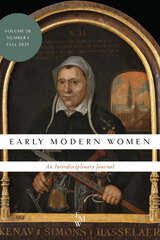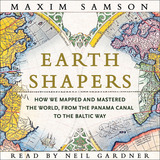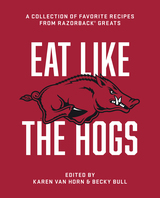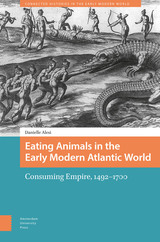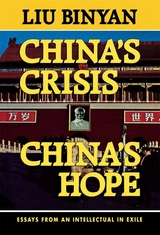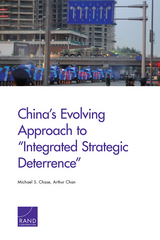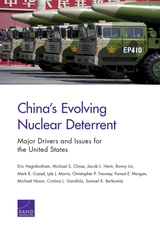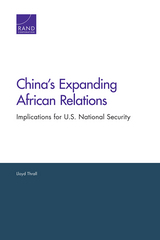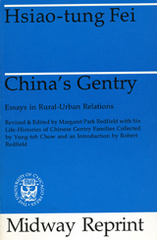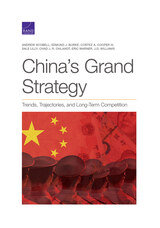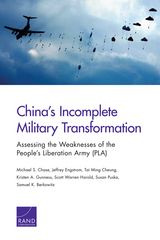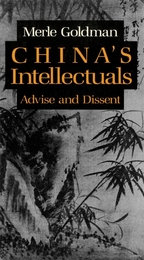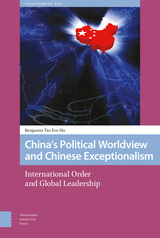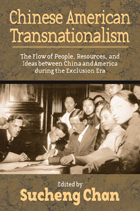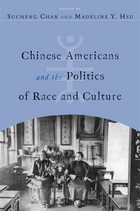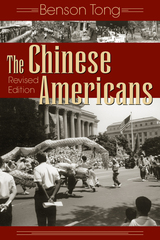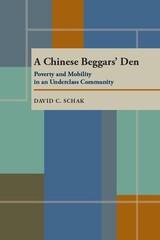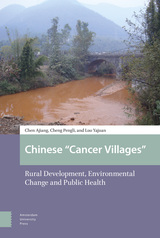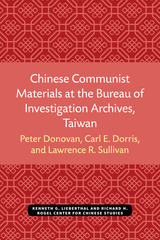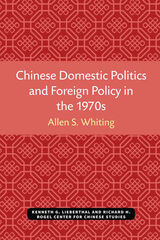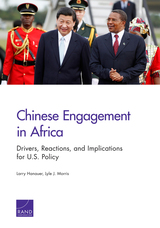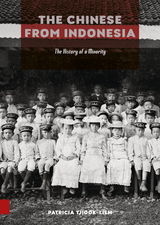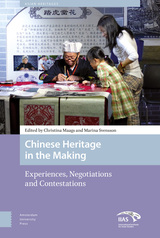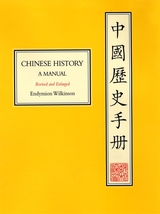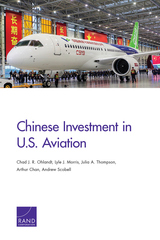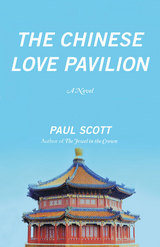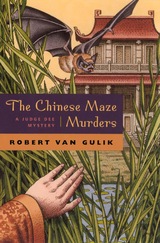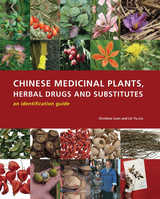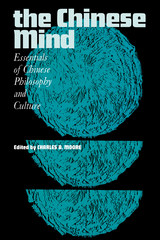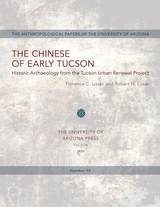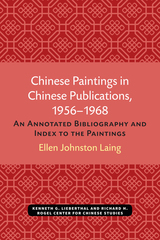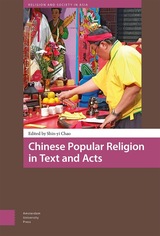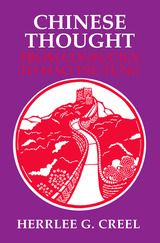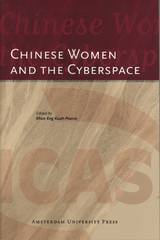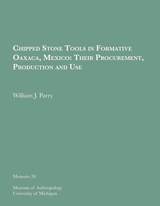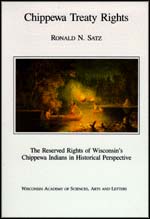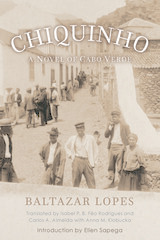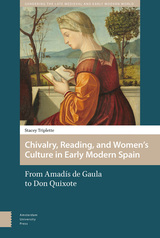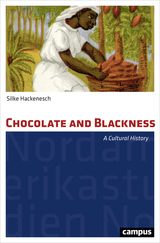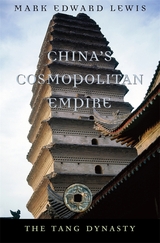 China’s Cosmopolitan Empire: The Tang Dynasty
Mark Edward Lewis
Harvard University Press, 2012 The Tang dynasty is often called China’s “golden age,” a period of commercial, religious, and cultural connections from Korea and Japan to the Persian Gulf, and a time of unsurpassed literary creativity. Mark Lewis captures a dynamic era in which the empire reached its greatest geographical extent under Chinese rule, painting and ceramic arts flourished, women played a major role both as rulers and in the economy, and China produced its finest lyric poets in Wang Wei, Li Bo, and Du Fu.
The Chinese engaged in extensive trade on sea and land. Merchants from Inner Asia settled in the capital, while Chinese entrepreneurs set off for the wider world, the beginning of a global diaspora. The emergence of an economically and culturally dominant south that was controlled from a northern capital set a pattern for the rest of Chinese imperial history. Poems celebrated the glories of the capital, meditated on individual loneliness in its midst, and described heroic young men and beautiful women who filled city streets and bars.
Despite the romantic aura attached to the Tang, it was not a time of unending peace. In 756, General An Lushan led a revolt that shook the country to its core, weakening the government to such a degree that by the early tenth century, regional warlordism gripped many areas, heralding the decline of the Great Tang.
China’s Crisis, China’s Hope
Binyan Liu
Harvard University Press, 1990 The principal force in awakening the people and setting them on the road to struggle, Liu Binyan argues, has been the repeated mistakes of the Chinese Communist Party and the outrageous bureaucratic corruption it has allowed to flourish. Even as he describes the runaway inflation that inflicts unfathomable hardship on all but the elite party officials, the increasing isolation and hypocrisy of the Communist leadership, or the political persecution of intellectuals and the press, Liu’s message is one of hope. This book—written in one man’s eloquent voice—is testimony to his belief that the need for democratic reform has taken root among the Chinese people and that they will ultimately take steps to transform their nation.
 China’s Crony Capitalism: The Dynamics of Regime Decay
Minxin Pei
Harvard University Press, 2016 When Deng Xiaoping launched China on the path to economic reform in the late 1970s, he vowed to build “socialism with Chinese characteristics.” More than three decades later, China’s efforts to modernize have yielded something very different from the working people’s paradise Deng envisioned: an incipient kleptocracy, characterized by endemic corruption, soaring income inequality, and growing social tensions. China’s Crony Capitalism traces the origins of China’s present-day troubles to the series of incomplete reforms from the post-Tiananmen era that decentralized the control of public property without clarifying its ownership.
Beginning in the 1990s, changes in the control and ownership rights of state-owned assets allowed well-connected government officials and businessmen to amass huge fortunes through the systematic looting of state-owned property—in particular land, natural resources, and assets in state-run enterprises. Mustering compelling evidence from over two hundred corruption cases involving government and law enforcement officials, private businessmen, and organized crime members, Minxin Pei shows how collusion among elites has spawned an illicit market for power inside the party-state, in which bribes and official appointments are surreptitiously but routinely traded. This system of crony capitalism has created a legacy of criminality and entrenched privilege that will make any movement toward democracy difficult and disorderly.
Rejecting conventional platitudes about the resilience of Chinese Communist Party rule, Pei gathers unambiguous evidence that beneath China’s facade of ever-expanding prosperity and power lies a Leninist state in an advanced stage of decay.
 China’s Date Debate: How Manchurian Scholars Rewrote World War II
Emily Matson
University of Michigan Press, 2026 China’s Date Debate is an in-depth investigation of the Chinese Communist Party’s remapping of China’s World War II timeline from eight years (1937-–1945) to fourteen years (1931–1945). Instead of the previously accepted starting date of the Marco Polo Bridge Incident on July 7, 1937, the Chinese Communist Party defined the war’s starting date as the Mukden Incident on September 18, 1931, which triggered the Japanese Kwantung Army’s invasion of Manchuria. Since the 1980s, scholars from Manchuria have demanded a fourteen-year war timeline to encompass the invasion of their homeland. By the 1990s, other scholars took notice and started to counter with claims that the eight-year timeline was the more accurate. Subsequently, a fierce “date debate” emerged between the two sides that was only resolved by the 2017 proclamation from the Ministry of Education.
Emily Matson demonstrates that the decision to set China's World War II timeline at fourteen years was not merely a top-down decision, but was influenced by decades of Manchurian scholarship on the war. China’s Date Debate recenters Manchuria as a region of critical importance for China’s national identity today and the implications of this “date debate” on the Chinese Communist Party’s domestic legitimacy and international image.
 China’s Development Experience in Comparative Perspective
Robert F. Dernberger
Harvard University Press, 1980 While comparing China’s economic development policies to those of other developing countries, this book clearly identifies the features that makes China unique. A group of international experts presents essays that summarize the general characteristics of the Chinese economy, beginning with an overview of the development process in the Third World as a whole. They then examine three areas of China’s development program that are most frequently cited as success stories—income distribution, industrial technology, and public health—carefully documenting the degree to which these successes depend on the political and social environment. Finally, they discuss several themes of China’s contemporary development strategy and their historical antecedents, speculating on the transferability of China’s experience to other Third World countries. Synthesizing economic theory and empirical documentation, this book offers an analysis of China’s fundamental organization that will not soon be outdated.
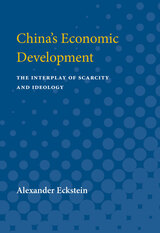 China's Economic Development: The Interplay of Scarcity and Ideology
Alexander Eckstein
University of Michigan Press, 1975 China's Economic Development: The Interplay of Scarcity and Ideology by Alexander Eckstein provides a comprehensive analysis of China's economic growth and transformation from a socialist economy. Eckstein examines the unique challenges China faced in addressing its economic backwardness, such as scarcity of resources and ideological constraints, and compares its industrialization to other countries. The book explores how Maoist ideology and policy initiatives impacted the country's economic strategies, leading to a fluctuating development pattern characterized by rapid expansion in the 1950s and stagnation in the 1960s. Key themes include the dichotomy between scarcity and ideology, the influence of historical factors on economic structures, and the adaptation to Soviet models. Eckstein sheds light on how China navigated its unique size, population pressures, and low per capita income, arguing that understanding these dynamics is crucial for both development theory and policy design. This volume, part of the Michigan Studies on China series, compiles essays and research that contribute to a nuanced understanding of China's economic systems, with particular focus on the tensions between ideological aspirations and economic realities.
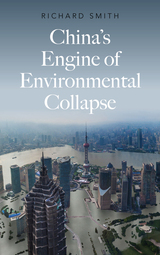 China’s Engine of Environmental Collapse
Richard Smith
Pluto Press, 2020 As the world hurtles towards environmental oblivion, China is leading the charge. The nation's CO2 emissions are more than twice those of the US with a GDP just two-thirds as large. China leads the world in renewable energy yet it is building new coal-fired power plants faster than renewables. The country's lakes, rivers, and farmlands are severely polluted yet China's police state can't suppress pollution, even from its own industries. This is the first book to explain these contradictions. Richard Smith explains how the country's bureaucratic rulers are driven by nationalist-industrialist tendencies that are even more powerful than the drive for profit under 'normal' capitalism. In their race to overtake the US they must prioritise hyper-growth over the environment, even if this ends in climate collapse and eco-suicide. Smith contends that nothing short of drastic shutdowns and the scaling back of polluting industries, especially in China and the US, will suffice to slash greenhouse gas emissions enough to prevent climate catastrophe.
China's Environment and China's Environment Journalists: A Study
Hugo de Burgh and Zeng Rong
Intellect Books, 2012 Environmental issues are of growing concern in China, with numerous initiatives aimed at encouraging dialogue and increasing awareness. And key to these initiatives is the environmental journalist. The first English-language study of this burgeoning field, this book investigates Chinese environmental journalists—their methodologies, their attitudes toward the environment, and their views on the significance of their work—and concludes that most respond enthusiastically to government promptings to report on the environment and climate change. Additional chapters demonstrate journalists’ impact in helping to shape governmental decision making.
China’s Evolving Approach to “Integrated Strategic Deterrence”
Michael S. Chase
RAND Corporation, 2016 Drawing on Chinese military writings, this report finds that China’s strategic-deterrence concepts are evolving in response to Beijing’s changing assessment of its external security environment and a growing emphasis on protecting its emerging interests in space and cyberspace. China also is rapidly closing what was once a substantial gap between the People’s Liberation Army’s strategic weapons capabilities and its strategic-deterrence concepts.
China’s Evolving Nuclear Deterrent: Major Drivers and Issues for the United States
Eric Heginbotham
RAND Corporation, 2017 China’s approach to nuclear deterrence has been broadly consistent since its first test in 1964, but it has recently accelerated nuclear force modernization. China’s strategic environment is likely to grow more complex, and nuclear constituencies are gaining a larger bureaucratic voice. Beijing is unlikely to change official nuclear policies but will probably increase emphasis on nuclear deterrence and may adjust the definition of key concepts.
China’s Expanding African Relations: Implications for U.S. National Security
Lloyd Thrall
RAND Corporation, 2015 Across economic, political, and security domains, the growth of China’s presence in Africa has been swift and staggering, which has fed both simplistic caricatures of China’s role on the continent and fears of renewed geopolitical competition. A closer look reveals a more balanced picture. This report examines how China’s growing engagement affects the United States’ role in Africa and offers policy recommendations for U.S. military leaders.
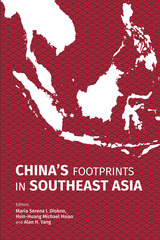 China's Footprints in Southeast Asia
Edited by Maria Serena I. Diokno, Hsin-Huang Michael Hsiao, and Alan H. Yang
National University of Singapore Press, 2018 The countries that make up Southeast Asia are seeing an incredible resurgence in their economic power. Over the past fifty years, their combined wealth has reached the same level as the United Kingdom and, taken together, they are on track to become the fifth-largest world economy. But that stability and success has drawn the attention of the second largest world economy—China. The emerging superpower is increasingly involved in Southeast Asia as part of the ongoing global realignment. As China deepens its influence across the region, the countries of Southeast Asia are negotiating spaces for themselves in order to respond to—or even challenge—China’s power.
This is the first book to survey China’s growing role in Southeast Asia along multiple dimensions. It looks closely and skeptically at the multitude of ways that China has built connections in the region, including through trade, foreign aid, and cultural diplomacy. It incorporates examples such as the operation of Confucius Institutes in Indonesia or the promotion of the concept of guangxi.China’s Footprints in Southeast Asia raises the question of whether the Chinese efforts are helpful or disruptive and explores who it is that really stands to benefit from these relationships. The answers differ from country to country, but, as this volume suggests, the footprint of hard and soft power always leaves a lasting mark on other countries’ institutions.
 China’s Foreign Places: The Foreign Presence in China in the Treaty Port Era, 1840–1943
Robert Nield
Hong Kong University Press, 2015 During the nineteenth and early twentieth centuries, the imperial powers—principally Britain, the United States, Russia, France, Germany and Japan—signed treaties with China to secure trading, residence and other rights in cities on the coast, along important rivers, and in remote places further inland. The largest of them—the great treaty ports of Shanghai and Tientsin—became modern cities of international importance, centres of cultural exchange and safe havens for Chinese who sought to subvert the Qing government. They are also lasting symbols of the uninvited and often violent incursions by foreign powers during China’s century of weakness. The extraterritorial privileges that underpinned the treaty ports were abolished in 1943—a time when much of the treaty port world was under Japanese occupation. China’s Foreign Places provides a historical account of the hundred or more major foreign settlements that appeared in China during the period 1840 to 1943. Most of the entries are about treaty ports, large and small, but the book also includes colonies, leased territories, resorts and illicit centres of trade. Information has been drawn from a wide range of sources and entries are arranged alphabetically with extensive illustrations and maps. China’s Foreign Places is both a unique work of reference, essential for scholars of this period and travellers to modern China. It is also a fascinating account of the people, institutions and businesses that inhabited China’s treaty port world.
China's Foreign Trade Statistics, 1864-1949
Liang-lin Hsiao
Harvard University Press, 1974 The Chinese Maritime Customs began publishing China's foreign trade statistics in the early 1860s. Over time, its publications accumulated into an impressive collection. By arranging the relevant data of more than 80 years in a systematic form, this Handbook has removed a major stumbling block confronting research in this area. It contains all important statistical series in the Customs publications, including about 100 in commodities, 20 in countries, 10 in ports, and over 80 in shipping. It also introduces an adjusted imports and exports series which is more consistent than the Customs own data.
In addition to providing a few hundred well arranged relevant statistical series, this Handbook traces the development and changes in concept and procedure in the Customs statistics.
 China's Forty Millions: Minority Nationalities and National Integration in the People's Republic of China
June Teufel Dreyer
Harvard University Press, 1976 The problem of melding diverse ethnic groups into a single political entity is as old as human history. Marx's predictions to the contrary, modern socialist states have not escaped the tension of nationality: contentment or rebellion, pluralism or assimilation. June Teufel Dreyer, in what will be the basic study in its field, delineates China's determination to deal intelligently with its minorities.
The “forty millions” (Mongols, Tibetans, Koreans, Manchus, and some fifty other groups) are only 6 percent of China's total population, but the national government pays them special attention. First of all, these groups occupy almost two thirds of China's land area, in strategic frontier positions. Second, they occupy terrain rich in unworked minerals, undeveloped forests, and prolific supplies of domestic animals. The People's Republic attaches considerable importance to obtaining loyalty and maintaining political jurisdiction.
Dreyer examines the steps taken to achieve integration. In the process she also considers how the Communist Party's minority policy differs from that of previous Chinese governments and the Soviet Union; who the executors of this policy have been; what mechanisms have been used to carry it out; how minorities have reacted to the communist system; and how policy toward minorities differs from policy toward the Han majority. This deeply researched book is informed by considerations that transcend the Chinese setting. Many nations share the problem of race relations, and one nation's effort can lead to another nation's solution.
China's Gentry: Essays on Rural-Urban Relations
Hsiao-tung Fei
University of Chicago Press, 1980 These seven essays on the structure of Chinese society are based on articles contributed by Fei to Chinese newspapers in 1947 and 1948. Six case histories from a study of the gentry by Yung-teh Chow are appended.
"The chief interest and charm of this book lie in the fact that it is not directed to the Western reader; these were studies written in Chinese, by an erudite Chinese, for a Chinese public. . . . Mrs. Redfield is to be complimented for her own careful research in preparing this translation for a non-Chinese public."—Robert F. Spencer, American Anthropologist
 China's Global Identity: Considering the Responsibilities of Great Power
Hoo Tiang Boon
Georgetown University Press, 2018 China is today regarded as a major player in world politics, with growing expectations for it to do more to address global challenges. Yet relatively little is known about how it sees itself as a great power and understands its obligations to the world. In China’s Global Identity, Hoo Tiang Boon embarks on the first sustained study of China’s great power identity. Focus is drawn to China’s positioning of itself as a responsible power and the underestimated role played by the United States in shaping this face. In 1995 President Bill Clinton notably called for China to become a responsible great power, one that integrates itself into existing international institutions and becomes a leader in solving global problems. Chinese leaders were at that time already debating their future course and obligations to the world. Hoo examines this ongoing internal debate through Chinese sources and reveals the underestimated role that the United States has in this dialogue. Unraveling the big power politics, history, events, and ideas behind the emergence and evolution of China’s great power identity, the book provides fresh insights into the real-world issues of how China might use its power as it grows. The question of China’s role as a responsible power has real-world implications for its diplomacy and trajectory, as well as the responses of states adjusting to these shifts. The book offers a new lens for scholars, policy professionals, diplomats, and students in the fields of international relations and Asian affairs to make sense of China’s rise and its impact on America and global order.
 China's Global Strategy: Towards a Multipolar World
Jenny Clegg
Pluto Press, 2009 China is fast emerging as a powerful player on the world stage. This book takes a closer look at the country's stance on a range of global issues, arguing that its multipolar diplomacy offers a concrete strategy to constrain the US pursuit of unipolar primacy.
Many people assume that China will follow an imperialistic strategy and therefore be in direct conflict with the American empire in a quest for world domination. Jenny Clegg shows that China is in fact taking a multilateral approach, offering real assistance to developing countries and helping to build the institutions required to run a multipolar world. Without glossing over China's own internal difficulties, the book argues that its international consensus-building strategy could lead to a more peaceful and equitable world.
This book offers a refreshing perspective on China that will be of great value to those interested in the big political questions of how to tackle war and imperialism, globalisation and development as well as to undergraduate students of politics, economics and international relations.
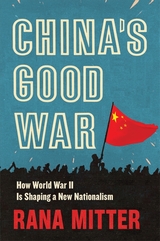 China’s Good War: How World War II Is Shaping a New Nationalism
Rana Mitter
Harvard University Press, 2020 A Foreign Affairs Book of the Year
A Spectator Book of the Year
“Insightful…a deft, textured work of intellectual history.”
—Foreign Affairs
“A timely insight into how memories and ideas about the second world war play a hugely important role in conceptualizations about the past and the present in contemporary China.”
—Peter Frankopan, The Spectator
For most of its history, China frowned on public discussion of the war against Japan. But as the country has grown more powerful, a wide-ranging reassessment of the war years has been central to new confidence abroad and mounting nationalism at home.
Encouraged by reforms under Deng Xiaoping, Chinese scholars began to examine the long-taboo Guomindang war effort, and to investigate collaboration with the Japanese and China’s role in the post-war global order. Today museums, television shows, magazines, and social media present the war as a founding myth for an ascendant China that emerges as victor rather than victim. One narrative positions Beijing as creator and protector of the international order—a virtuous system that many in China now believe to be under threat from the United States. China’s radical reassessment of its own past is a new founding myth for a nation that sees itself as destined to shape the world.
“A detailed and fascinating account of how the Chinese leadership’s strategy has evolved across eras…At its most interesting when probing Beijing’s motives for undertaking such an ambitious retooling of its past.”
—Wall Street Journal
“The range of evidence that Mitter marshals is impressive. The argument he makes about war, memory, and the international order is…original.”
—The Economist
China’s Grand Strategy: Trends, Trajectories, and Long-Term Competition
Andrew Scobell
RAND Corporation, 2020 To explore what extended competition between the United States and China might entail out to 2050, the authors of this report identified and characterized China’s grand strategy, analyzed its component national strategies (diplomacy, economics, science and technology, and military affairs), and assessed how successful China might be at implementing these over the next three decades.
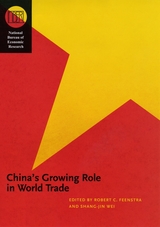 China's Growing Role in World Trade
Edited by Robert C. Feenstra and Shang-Jin Wei
University of Chicago Press, 2010 In less than three decades, China has grown from playing a negligible role in international trade to being one of the world's largest exporters, a substantial importer of raw materials, intermediate outputs, and other goods, and both a recipient and source of foreign investment. Not surprisingly, China's economic dynamism has generated considerable attention and concern in the United States and beyond. While some analysts have warned of the potential pitfalls of China's rise—the loss of jobs, for example—others have highlighted the benefits of new market and investment opportunities for US firms.
Bringing together an expert group of contributors, China's Growing Role in World Trade undertakes an empirical investigation of the effects of China's new status. The essays collected here provide detailed analyses of the microstructure of trade, the macroeconomic implications, sector-level issues, and foreign direct investment. This volume's careful examination of micro data in light of established economic theories clarifies a number of misconceptions, disproves some conventional wisdom, and documents data patterns that enhance our understanding of China's trade and what it may mean to the rest of the world.
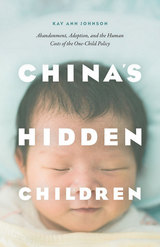 China's Hidden Children: Abandonment, Adoption, and the Human Costs of the One-Child Policy
Kay Ann Johnson
University of Chicago Press, 2016 In the thirty-five years since China instituted its One-Child Policy, 120,000 children—mostly girls—have left China through international adoption, including 85,000 to the United States. It’s generally assumed that this diaspora is the result of China’s approach to population control, but there is also the underlying belief that the majority of adoptees are daughters because the One-Child Policy often collides with the traditional preference for a son. While there is some truth to this, it does not tell the full story—a story with deep personal resonance to Kay Ann Johnson, a China scholar and mother to an adopted Chinese daughter.
Johnson spent years talking with the Chinese parents driven to relinquish their daughters during the brutal birth-planning campaigns of the 1990s and early 2000s, and, with China’s Hidden Children, she paints a startlingly different picture. The decision to give up a daughter, she shows, is not a facile one, but one almost always fraught with grief and dictated by fear. Were it not for the constant threat of punishment for breaching the country’s stringent birth-planning policies, most Chinese parents would have raised their daughters despite the cultural preference for sons. With clear understanding and compassion for the families, Johnson describes their desperate efforts to conceal the birth of second or third daughters from the authorities. As the Chinese government cracked down on those caught concealing an out-of-plan child, strategies for surrendering children changed—from arranging adoptions or sending them to live with rural family to secret placement at carefully chosen doorsteps and, finally, abandonment in public places. In the twenty-first century, China’s so-called abandoned children have increasingly become “stolen” children, as declining fertility rates have left the dwindling number of children available for adoption more vulnerable to child trafficking. In addition, government seizures of locally—but illegally—adopted children and children hidden within their birth families mean that even legal adopters have unknowingly adopted children taken from parents and sent to orphanages.
The image of the “unwanted daughter” remains commonplace in Western conceptions of China. With China’s Hidden Children, Johnson reveals the complex web of love, secrecy, and pain woven in the coerced decision to give one’s child up for adoption and the profound negative impact China’s birth-planning campaigns have on Chinese families.
China’s Incomplete Military Transformation: Assessing the Weaknesses of the People’s Liberation Army (PLA)
Michael S. Chase
RAND Corporation, 2015 Through extensive primary source analysis and independent analysis, this report seeks to answer a number of important questions regarding the state of China’s armed forces. The authors found that the PLA is keenly aware of its many weaknesses and is vigorously striving to correct them. Although it is only natural to focus on the PLA’s growing capabilities, understanding the PLA’s weaknesses—and its self-assessments—is no less important.
China's Inner Asian Frontier: Photographs of the Wulsin Expedition to Northwest China in 1923
Mary Ellen Alonso
Harvard University Press, 1979 These 100 extraordinary photographs, selected from over two thousand taken by Frederick R. Wulsin during his 1923 expedition to the northwest borders of China, document the interplay of culture and way of life among Mongols, Tibetans, and Hans. The photographs are supplemented by extensive selections from Wulsin’s journals and letters that offer a comprehensive portrait of these societies at a critical moment of transition. Joseph Fletcher places it in the context of centuries of shifting patterns of empires and ethnic dominance, which continues to this day. M. E. Alonso contributes an essay on Wulsin, and the expedition. The photographs are taken from the archives of the National Geographic Society and Harvard’s Peabody Museum.
China’s Intellectuals: Advise and Dissent
Merle Goldman
Harvard University Press, 1981 Suppression and thaw have marked the course of communism in China. Merle Goldman traces that shifting pattern over the last decades of Mao’s regime, linking it to the unique role of the intellectual in government. Her engrossing account of the relations between the intellectuals and the governing elites provides a map of understanding to some recent events in the turbulent history of the People’s Republic.
 China’s Intellectuals and the State: In Search of a New Relationship
Merle Goldman
Harvard University Press, 1987 Today’s intellectuals in China inherit a mixed tradition in terms of their relationship to the state. Some follow the Confucian literati watchdog role of criticizing abuses of political power. Marxist intellectuals judge the state’s practices on the basis of Communist ideals. Others prefer the May Fourth spirit, dedicated to the principles of free scholarly and artistic expression. The Chinese government, for its part, has undulated in its treatment of intellectuals, applying restraints when free expression threatened to get “out of control,” relaxing controls when state policies required the cooperation, good will, and expertise of intellectuals.
In this stimulating work, twelve China scholars examine that troubled and changing relationship. They focus primarily on the post-Mao years when bitter memories of the Cultural Revolution and China’s renewed quest for modernization have at times allowed intellectuals increased leeway in expression and more influence in policy-making. Specialists examine the situation with respect to economists, lawyers, scientists and technocrats, writers, and humanist scholars in the climate of Deng Xiaoping’s policies, and speculate about future developments. This book will be a valuable source of information for anyone interested in the changing scene in contemporary China and in its relations with the outside world.
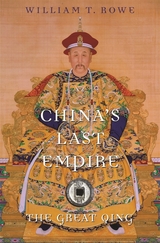 China's Last Empire: The Great Qing
William T. Rowe
Harvard University Press, 2011 In a brisk revisionist history, William Rowe challenges the standard narrative of Qing China as a decadent, inward-looking state that failed to keep pace with the modern West.
The Great Qing was the second major Chinese empire ruled by foreigners. Three strong Manchu emperors worked diligently to secure an alliance with the conquered Ming gentry, though many of their social edicts—especially the requirement that ethnic Han men wear queues—were fiercely resisted. As advocates of a “universal” empire, Qing rulers also achieved an enormous expansion of the Chinese realm over the course of three centuries, including the conquest and incorporation of Turkic and Tibetan peoples in the west, vast migration into the southwest, and the colonization of Taiwan.
Despite this geographic range and the accompanying social and economic complexity, the Qing ideal of “small government” worked well when outside threats were minimal. But the nineteenth-century Opium Wars forced China to become a player in a predatory international contest involving Western powers, while the devastating uprisings of the Taiping and Boxer rebellions signaled an urgent need for internal reform. Comprehensive state-mandated changes during the early twentieth century were not enough to hold back the nationalist tide of 1911, but they provided a new foundation for the Republican and Communist states that would follow.
This original, thought-provoking history of China’s last empire is a must-read for understanding the challenges facing China today.
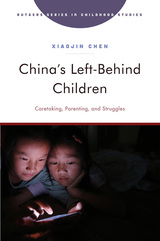 China's Left-Behind Children: Caretaking, Parenting, and Struggles
Xiaojin Chen
Rutgers University Press, 2024 One unintended consequence of the unprecedented rural-to-urban migration in China over the past three decades is the exponentially increased number of "left-behind" children—children whose parents migrated to more developed areas and who live with one parent or other extended family members. The daily lives of these children, including their caretaking arrangements, parent-child bonding and communication, and schooling, are fraught with distractions and uncertainties. Paying special attention to this marginalized group, this book investigates the role of parental migration and the left-behind status in shaping Chinese family dynamics and children’s general wellbeing, including their school performance, delinquency, resilience, feelings of ambiguous loss, and other psychological problems. Blending theory, empirical research, and real-world interviews with left-behind children, China's Left-Behind Children provides a uniquely close look at these children's lives while also providing the larger national context that defines and shapes their everyday lives.
China’s Local Councils in the Age of Constitutional Reform, 1898–1911
Roger R. Thompson
Harvard University Press, 1995 Dazzled by the model of Japan’s Western-style constitutional government, Chinese officials and elite activists made plans to establish locally elected councils. By October 1911, government agencies had reported the establishment of about 5,000 councils.
Throughout the period, data on self-government reforms collected from localities were compiled in provincial capitals, then collated, summarized, and archived in Beijing. Simultaneously, directives were being sent from the capital to the provinces. From this wealth of previously unexamined material, Roger R. Thompson draws a portrait-in-motion of the reforms. He demonstrates the energy and significance of the late-Qing local-self-government movement, while making a compelling case that it was separate from the well-studied phenomenon of provincial assemblies and constitutionalism in general.
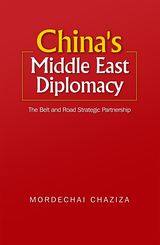 China's Middle East Diplomacy: The Belt and Road Strategic Partnership
Mordechai Chaziza
Sussex Academic Press, 2022 The People's Republic of China (PRC) diplomatic engagement with the Middle East spans multiple dimensions, including trade and investment, the energy sector, and military cooperation. Connecting China through the Suez Canal to the Mediterranean and Europe, the Middle East is a unique geostrategic location for Beijing, a critical source of energy resources, and an area of expanding economic ties.
The Middle East geographical and political area is subject to different country inclusion interpretations that have changed over time and reflect complex and multifaceted circumstances involving conflict, religion, ethnicity, and language. China considers most Arab League member countries (as well as Israel, Turkey, and Iran) as representing the Middle East. The Ministry of Foreign Affairs and official Chinese publications refer to this region as Xiya beifei (West Asia and North Africa). China sees the Middle East as an intrinsic part of its Belt and Road Initiative (BRI), and has ramped up investment in the region accordingly, focusing on energy (including nuclear power), infrastructure construction, agriculture, and finance.
This book uses the BRI as a framework for analyzing ChinaMiddle East relations, with special emphasis on the PRC's strategic partnerships via regional mutual interdependency in various sectors such as energy, infrastructure building, political ties, trade and investment, financial integration, people to people bonding, and defense. A stable Middle East region is vital for China's sustainable growth and continued prosperity. As the world's largest oil consumer with an ambition to expand its economic and political influence, the Middle East's geostrategic location and holder of most of the world's known energy resources make it indispensable to the success of the Belt and Road Initiative.
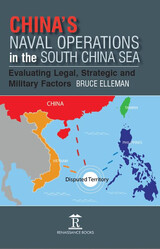 China’s Naval Operations in the South China Sea: Evaluating Legal, Strategic and Military Factors
Bruce Elleman
Amsterdam University Press, 2018 This book provides a history of the South China Sea conflict and lays out the stakes for each of the bordering states and China’s interaction with them – namely, Vietnam, the Philippines, Brunei, Malaysia, Taiwan, and Indonesia; it also examines the U.S. government’s role in the region. China’s Naval Operations in the South China Sea is highly topical; it examines the evolving perception of the People’s Republic of China’s (PRC) of the South China Sea (SCS), and Beijing’s accompanying maritime strategy to claim the islands and waters, particularly in the context of the strategies of the neighbouring stake-holding nations. In addition to long-standing territorial disputes over the islands and waters of the SCS, China and the other littoral states — Vietnam, the Philippines, Brunei, Malaysia, Taiwan, and Indonesia — have growing and often mutually exclusive interests in the offshore energy reserves and fishing grounds. Many other countries outside of the region worry about the protection of sea lines of communication for military and commercial traffic, oil tankers in particular. These differences have been expressed in the increasing frequency and intensity of maritime incidents, involving both naval and civilian vessels, sometimes working in coordination against naval or civilian targets. Each chapter on the littoral states closely examines that state’s territorial claims to the islands and waters of the SCS, its primary economic and military interests in these areas, its views on the sovereignty disputes over the entire SCS, its strategy to achieve its objectives, and its views on the U.S. involvement in any and all of these issues.
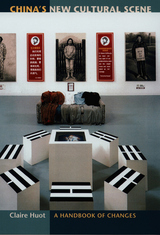 China's New Cultural Scene: A Handbook of Changes
Claire Huot
Duke University Press, 2000 The Cultural Revolution of China’s Maoist era has come and gone, yet another cultural revolution of a different sort has been sweeping through China in the 1990s. Although recently much interest has been focused on China’s economy, few Westerners are aware of the remarkable transformations occurring in the culture of ordinary people’s daily lives. In China’s New Cultural Scene Claire Huot surveys the wide spectrum of art produced by Chinese musicians, painters, writers, performers, and filmmakers today, portraying an ongoing cultural revolution that has significantly altered life in the People’s Republic.
Western observers who were impressed by the bravery of the demonstrators in Tiananmen Square—and stunned at the harshness of their suppression—will learn from this book how that political movement led to changes in cultural conditions and production. Attending to all the major elements of this vast nation’s high and low culture at the end of a landmark decade, Huot’s discussion ranges from the cinematic works of Zhang Yimou, Chen Kaige, and others to emerging musical forms such as rock, punk, and rap. Other topics include television, theater, and avant-garde art, the new electronic media, and subversive trends in both literature and the visual arts.
With a comprehensive index of artists and works, as well as a glossary of Chinese words, China’s New Cultural Scene will enlighten students of Chinese culture and general readers interested in contemporary Asia.
 China’s New Order: Society, Politics, and Economy in Transition
Wang Hui
Harvard University Press, 2003 As the world is drawn together with increasing force, our long-standing isolation from—and baffling ignorance of—China is ever more perilous. This book offers a powerful analysis of China and the transformations it has undertaken since 1989.
Wang Hui is unique in China’s intellectual world for his ability to synthesize an insider’s knowledge of economics, politics, civilization, and Western critical theory. A participant in the Tiananmen Square movement, he is also the editor of the most important intellectual journal in contemporary China. He has a grasp and vision that go beyond contemporary debates to allow him to connect the events of 1989 with a long view of Chinese history. Wang Hui argues that the features of contemporary China are elements of the new global order as a whole in which considerations of economic growth and development have trumped every other concern, particularly those of democracy and social justice. At its heart this book represents an impassioned plea for economic and social justice and an indictment of the corruption caused by the explosion of “market extremism.”
As Wang Hui observes, terms like “free” and “unregulated” are largely ideological constructs masking the intervention of highly manipulative, coercive governmental actions on behalf of economic policies that favor a particular scheme of capitalist acquisition—something that must be distinguished from truly free markets. He sees new openings toward social, political, and economic democracy in China as the only agencies by which the unstable conditions thus engendered can be remedied.
China's Political Worldview and Chinese Exceptionalism: International Order and Global Leadership
Benjamin Ho
Amsterdam University Press, 2021 China's Political Worldview and Chinese Exceptionalism: International Order and Global Leadership uses the notion of "Chinese exceptionalism" as a framework to analyze China's international politics and foreign policy. This book argues that China's approach to international relations is best understood in the context of these claims to exceptionalism and China's broader political world view. In doing so, it fosters a more comprehensive understanding of China's actions within the realms of foreign policy and international politics, and in the context of the preferred world order, norms and rules that the country seeks to promote.
 China’s Politics in Perspective
Harold S. Quigley
University of Minnesota Press, 1962
China's Politics in Perspective was first published in 1962. Minnesota Archive Editions uses digital technology to make long-unavailable books once again accessible, and are published unaltered from the original University of Minnesota Press editions.
In a concise, readable diagnosis of present-day China, this book provides the perspective which is needed for a realistic view of the Chinese situation today.
Professor Quigley introduces the reader to contemporary political, economic, and social conditions on the mainland and on Nationalist-held Taiwan by briefly reviewing the basic tenets of Confucianism and other classical philosophies, the principal aspects of the imperial system, and the domestic and foreign influences which contributed to the collapse of monarchy in 1911. He recalls the revolutionary doctrine of Sun Yat-sen and surveys the nature and conduct of government under the first and second republics and the forces that operated for and against the transfer of liberal ideals from paper to practice. After showing how the Communist leadership gained its foothold and present control, he discusses the ideologies of Mao Tse-tung and Chiang Kai-shek, the structure and administration of their governments and major parties, their economic, social, and foreign policies, the independence movement on Taiwan, the prospects for democracy and the dilemma in which the United States has been placed by the victory of the Communists over a wartime ally.
In addition to being appropriate for general readers and for study groups interested in contemporary affairs, the book is especially suitable for use as a college text.
 China’s Practice of International Law: Some Case Studies
Jerome Alan Cohen
Harvard University Press, 1972 In February 1967, at the height of the Cultural Revolution, the American Society of International Law organized a study panel of legal scholars, social scientists, lawyers, and government officials to consider problems relating to “China and International Order.” The panel was founded in the belief that the turmoil in China would not endure and that the People's Republic might soon wish to participate fully in the world community. To prepare for this day, the panel commissioned and reviewed a number of studies of China's interpretation and application of international law.
The ten essays in this volume—written by twelve scholars including Jerome Alan Cohen, who has also written a substantial introduction—are the fruit of this effort. Four of the essays deal with basic problems relating to Peking's international conduct: recognition and the establishment of diplomatic relations, the regulation of foreign diplomats serving in China, manipulation of the concept of “unequal treaties,” and the PRC's conditions for participation in international organizations. The other six essays focus on legal problems that have arisen in China's relations with a given country or international organization.
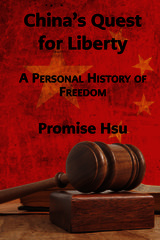 China's Quest for Liberty: A Personal History of Freedom
Promise Hsu
St. Augustine's Press, 2014 China’s Quest for Liberty is a personal story of a young man fully engaged in understanding the world he was born into and working toward making that world into a better and freer place to life. It is about an unexpected journey a Chinese journalist has taken to pursue freedom, involving such diverse fields or disciplines as politics, business, humanities, science and technology, government agencies and non-governmental organizations. Some took place as daily life, and some occurred in detentions or disasters.
It is about a world whose dimensions have been basically obscured not only in China but also in the global public square, and walk with this young journalist, step by step, to find, paradoxically, the hope in the depth of hopelessness, the strength in acknowledging weakness, the change in substance by, among other things, keeping the form unchanged for at least a while, the youth in growing up despite growing old, the invisible in the visible, the imperishable in the perishable, the reality in the shadow of numerous fake realities, and the freedom gained not mainly through human efforts but as mercy and grace from the one who created humans and other beings.
As well as digging out the overlooked Christian background in the rise of the sanctity of human life, creative culture, constitutionalism, work as a vocation, modern management, servant leadership, and catchphrases like “the global village” and “The medium is the message”, the author tells of insider observations about the rise of Christianity in China generally and about Shouwang Church in particular. Through sharing these findings, this book aims to show how the one who made the universe rules the world and how this creator sets his creatures free by himself.
China’s Quest for Liberty is a fascinating work of nuance and surprise.
 China’s Republican Revolution: The Case of Kwangtung, 1895–1913
Edward Rhoads
Harvard University Press, 1975 Imperialism, pernicious as it was in most respects, served as the prime catalyst for social change in China throughout the turbulent period from 1895 to 1913. Starting with this premise, Edward Rhoads traces the social, political, and economic history of the republican revolution. In his view, after the Boxer uprising, the Manchu court, usually called supine and reactionary, instituted a program of reform that was a serious, comprehensive, and often successful attempt at radical social transformation. It failed, but it politicized the Chinese people to an unprecedented degree—and it marks the entrance of China into the modern era. The post-Boxer reforms attracted many revolutionaries and defused a serious revolutionary threat. Contrary to traditional accounts, Sun Yat-sen and his Revolutionary Alliance did not move easily from success to success. On the eve of the 1911 revolution, in fact, the movement was disorganized and demoralized. Its ultimate victory came less from its own efforts than from the failure of the incumbent rulers to win the support of the nonrevolutionary elite.
 China's Response to the West: A Documentary Survey, 1839-1923
Harvard University Press, 1979 The present confrontation of Communist China and the United States, on which the future of peace in Asia hinges, is merely the latest phase in a continuing historical process--the remaking of China's ancient society under the stimulus of Western contact. How does it happen that a century of foreign trade and missionary evangelism, of modern education and the training of Chinese students in Western ways, has now resulted in a seeming rejection of the West? What has been the real nature of "China's response to the West" during the past century of our contact?
This volume gives the first inside account, on so broad a scale, of how China's leaders reacted to the invasion of Western arms and goods, persons and ideas, during the three generations from the Opium War to the rise of the Kuomintang. In 28 chapters, with translations of 65 key documents, the authors trace the stages by which the scholar-officials of the Middle Kingdom were brought to recognize successively the need for Western arms to defend their country, Western technology for making arms, modern science to support technology, its application in modern industry to strengthen the nation, and all the attendant new ideas which led them eventually into great movements for institutional reform, political revolution, and ideological reconstruction.
From the famous Commissioner un's first study of Western geography during his anti-opium crusade, through the efforts of Li Hungchang and others at "self-strengthening" by industrialization, down to the critical thought of Dr. Hu Shih and the eclecticism of Sun Yat-sen in the early 20th century, the writings of China's leaders ring the changes on a central theme how to remake their heritage and create a modern nation capable of meeting the West on equal terms. The provincial viceroys, the Reformers of 1898, the Boxers in 1900, the old Empress Dowager, and the eager students studying abroad, each in their own way, all grapple with this absorbing problem. The varied Chinese responses to the West in the formative century here analyzed give us a new insight into the springs of social action among one-fifth of mankind.
The companion volume, for the research specialist, provides Notes and Sources, Bibliography, and a Glossary of Chinese names and terms, essential bases for further exploration of this new field.
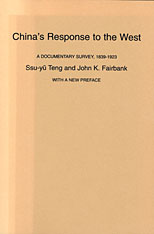 China’s Response to the West: A Documentary Survey, 1839–1923, With a New Preface
Ssu-yü Têng and John King Fairbank
Harvard University Press, 1979 The present confrontation of Communist China and the United States, on which the future of peace in Asia hinges, is merely the latest phase in a continuing historical process--the remaking of China's ancient society under the stimulus of Western contact. How does it happen that a century of foreign trade and missionary evangelism, of modern education and the training of Chinese students in Western ways, has now resulted in a seeming rejection of the West? What has been the real nature of "China's response to the West" during the past century of our contact?
This volume gives the first inside account, on so broad a scale, of how China's leaders reacted to the invasion of Western arms and goods, persons and ideas, during the three generations from the Opium War to the rise of the Kuomintang. In 28 chapters, with translations of 65 key documents, the authors trace the stages by which the scholar-officials of the Middle Kingdom were brought to recognize successively the need for Western arms to defend their country, Western technology for making arms, modern science to support technology, its application in modern industry to strengthen the nation, and all the attendant new ideas which led them eventually into great movements for institutional reform, political revolution, and ideological reconstruction.
From the famous Commissioner un's first study of Western geography during his anti-opium crusade, through the efforts of Li Hungchang and others at "self-strengthening" by industrialization, down to the critical thought of Dr. Hu Shih and the eclecticism of Sun Yat-sen in the early 20th century, the writings of China's leaders ring the changes on a central theme how to remake their heritage and create a modern nation capable of meeting the West on equal terms. The provincial viceroys, the Reformers of 1898, the Boxers in 1900, the old Empress Dowager, and the eager students studying abroad, each in their own way, all grapple with this absorbing problem. The varied Chinese responses to the West in the formative century here analyzed give us a new insight into the springs of social action among one-fifth of mankind.
The companion volume, for the research specialist, provides Notes and Sources, Bibliography, and a Glossary of Chinese names and terms, essential bases for further exploration of this new field.
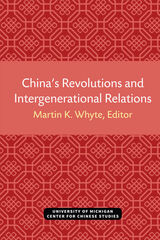 China’s Revolutions and Intergenerational Relations
Martin K. Whyte, Editor
University of Michigan Press, 2003 China’s Revolutions and Intergenerational Relations counters the widely accepted notion that traditional family patterns are weakened by forces such as economic development and social revolutions. China has experienced wrenching changes on both the economic and the political fronts, yet from the evidence presented here the tradition of filial respect and support for aging parents remains alive and well. Using collaborative surveys carried out in 1994 in the middle-sized industrial city of Baoding and comparative data from urban Taiwan, the authors examine issues shaping the relationships between adult Chinese children and their elderly parents. The continued vitality of intergenerational support and filial obligations in these samples is not simply an instance of strong Confucian tradition trumping powerful forces of change. Instead, and somewhat paradoxically, the continued strength of filial obligations can be attributed largely to the institutions of Chinese socialism forged in the era of Mao Zedong. With socialist institutions now under assault in the People’s Republic of China, the future of intergenerational relations in the twenty-first century is once again uncertain.
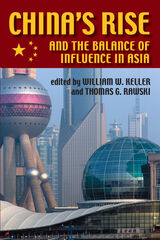 China's Rise and the Balance of Influence in Asia
William W. Keller
University of Pittsburgh Press, 2007
China's protracted boom and political transformation is a major episode in the history of global political economy. Beginning in the late 1970s, China experienced a quarter century of extraordinary growth that raised every indicator of material welfare, lifted several hundred million out of poverty, and rocketed China from near autarky to regional and even global prominence. These striking developments transformed China into a major U.S. trade and investment partner, a regional military power, and a major influence on national economies and cross-national interchange throughout the Pacific region. Beijing has emerged as a voice for East Asian economic interests and an arbiter in regional and even global diplomacy-from the Asian financial crisis to the North Korean nuclear talks. China's accession to the World Trade Organization promises to accentuate these trends.
The contributors to this volume provide a multifaceted examination of China in the areas of economics, trade, investment, politics, diplomacy, technology, and security, affording a greater understanding of what relevant policies the United States must develop. This book offers a counterweight to overwrought concerns about the emerging “Chinese threat” and makes the case for viewing China as a force for stability in the twenty-first century.
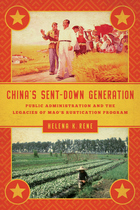 China's Sent-Down Generation: Public Administration and the Legacies of Mao's Rustication Program
Helena K. Rene
Georgetown University Press, 2012 During China’s Cultural Revolution, Chairman Mao Zedong’s "rustication program" resettled 17 million urban youths, known as "sent downs," to the countryside for manual labor and socialist reeducation. This book, the most comprehensive study of the program to be published in either English or Chinese to date, examines the mechanisms and dynamics of state craft in China, from the rustication program’s inception in 1968 to its official termination in 1980 and actual completion in the 1990s. Rustication, in the ideology of Mao's peasant-based revolution, formed a critical component of the Cultural Revolution's larger attack on bureaucrats, capitalists, the intelligentsia, and "degenerative" urban life. This book assesses the program’s origins, development, organization, implementation, performance, and public administrative consequences. It was the defining experience for many Chinese born between 1949 and 1962, and many of China's contemporary leaders went through the rustication program. The author explains the lasting impact of the rustication program on China's contemporary administrative culture, for example, showing how and why bureaucracy persisted and even grew stronger during the wrenching chaos of the Cultural Revolution. She also focuses on the special difficulties female sent-downs faced in terms of work, pressures to marry local peasants, and sexual harassment, predation, and violence. The author’s parents were both sent downs, and she was able to interview over fifty former sent downs from around the country, something never previously accomplished. China's Sent-Down Generation demonstrates the rustication program’s profound long-term consequences for China's bureaucracy, for the spread of corruption, and for the families traumatized by this authoritarian social experiment. The book will appeal to academics, graduate and undergraduate students in public administration and China studies programs, and individuals who are interested in China’s Cultural Revolution era.
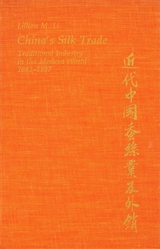 China’s Silk Trade: Traditional Industry in the Modern World, 1842–1937
Lillian M. Li
Harvard University Press, 1981 The development of modern China’s most important export commodity, silk, is traced from the opening of the treaty ports to the 1930s. This study examines the silk industry, one of China’s most advanced traditional economic enterprises, as it moved into large-scale trade with the West. And it especially considers whether traditional economic organizations and practices encouraged or inhibited the expansion of the industry and its technological modernization.
The silk industry is presented as a microcosm of China’s encounter with the modern world market, focusing on such topics as the role of the state, the relationship between treaty ports and rural producers, the domestic market, and the financing and organization of the modern sector. Such important issues as the “sprouts of capitalism” argument and Japan’s assumption of first position in the modern world silk market are authoritatively and convincingly illuminated.
 China's Strategic Arsenal: Worldview, Doctrine, and Systems
James M. Smith and Paul J. Bolt, Editors
Georgetown University Press, 2021 A critical look at how China’s growing strategic arsenal could impact a rapidly changing world order China’s strategic capabilities and doctrine have historically differed from the United States’ and Russia’s. China has continued to modernize and expand its arsenal despite its policy of no first use, while the United States and Russia have decreased deployed weapons stocks. This volume brings together an international group of distinguished scholars to provide a fresh assessment of China's strategic military capabilities, doctrines, and political perceptions in light of rapidly advancing technologies, an expanding and modernizing nuclear arsenal, and an increased great-power competition with the United States. Analyzing China's strategic arsenal is critical for a deeper understanding of China’s relations with both its neighbors and the world. Without a doubt, China’s arsenal is growing in size and sophistication, but key uncertainties also lie ahead. Will China’s new capabilities and confidence lead it to be more assertive and take more risks? Will China’s nuclear traditions change as the strategic balance improves? Will China’s approach to military competition be guided by a notion of strategic stability or not? Will there be a strategic arms race with the United States? China's Strategic Arsenal provides a current understanding of these issues as we strive for a stable strategic future with China.
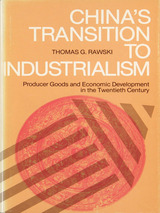 China's Transition to Industrialism
Thomas G. Rawski
University of Michigan Press, 1980 China's Transition to Industrialism studies the history and development of a group of industries which have played key roles in China's recent economic gains. Drawing on a wide range of materials, the author focuses on engineering, chemicals, and allied producer industries, showing how the growth of these sectors sparked a dynamic process of development which has spread to encompass the entire Chinese economy. Rawski traces this industrialization process to three distinct sources: vigorous prewar development in the private sector, which created a nucleus of experienced producers in Shanghai and other urban centers; the resource mobilization efforts of the post-1949 Communist government; and a series of economic reforms which relaxed the performance constraints found in other socialist economies and stimulated a burst of innovative activity which has propelled China's economy from the depression of the early 1960s to a record of economic achievement unmatched among the large nations of the developing world.
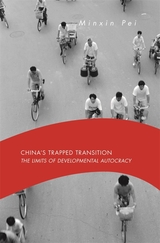 China’s Trapped Transition: The Limits of Developmental Autocracy
Minxin Pei
Harvard University Press, 2008 The rise of China as a great power is one of the most important developments in the twenty-first century. But despite dramatic economic progress, China’s prospects remain uncertain. In a book sure to provoke debate, Minxin Pei examines the sustainability of the Chinese Communist Party’s reform strategy—pursuing pro-market economic policies under one-party rule.
Pei casts doubt on three central explanations for why China’s strategy works: sustained economic development will lead to political liberalization and democratization; gradualist economic transition is a strategy superior to the “shock therapy” prescribed for the former Soviet Union; and a neo-authoritarian developmental state is essential to economic take-off. Pei argues that because the Communist Party must retain significant economic control to ensure its political survival, gradualism will ultimately fail.
The lack of democratic reforms in China has led to pervasive corruption and a breakdown in political accountability. What has emerged is a decentralized predatory state in which local party bosses have effectively privatized the state’s authority. Collusive corruption is widespread and governance is deteriorating. Instead of evolving toward a full market economy, China is trapped in partial economic and political reforms.
Combining powerful insights with empirical research, China’s Trapped Transition offers a provocative assessment of China’s future as a great power.
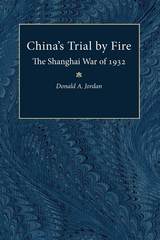 China's Trial by Fire: The Shanghai War of 1932
Donald A. Jordan
University of Michigan Press, 2001 China's Trial by Firepresents the balanced history of how, ten years before Pearl Harbor, Japan tested modern China in a thirty-three-day war, now known as the Shanghai War of1932. Often obscured by the larger World War II, this history details how the Chinese fought from trenches against Japan's modern bombers and navy, and formed a defense that brought the country together for the first time.
Unlike other histories' brief generalizations of the incident, this study traces the war from the initial January 28th Japanese marine raid on Chinese Shanghai. It also studies the roles played by the prevailing Japanese leaders, including the last prewar civilian Prime Minister, Emperor Hirohito, and Admiral Nomura, who was later assigned to pre-Pearl Harbor negotiations.
Not least, the work bridges scholarly boundaries by highlighting the economics of China's leading trade metropolis, Shanghai; the desperate attempts of Chinese politicians and press to manipulate anti-imperialist and anti-Japanese propaganda; and the ways in which the failure of positional trench warfare against Japanese mechanized mobility provided lessons to German observers and the Communists.
Donald Jordan has drawn from as complete a range of primary sources as are available. Both the Nanking and Taipei archives, as well as resources from Tokyo, Settlement Shanghai's police records, Washington, the League of Nations, and London were researched.
Knowing how greatly the Nationalist defense in 1932 influenced the Chinese Communists expands the relevance for scholars of this illustrated study. Others, especially those curious about the U. S. entanglement leading to Pearl Harbor, will find much more than the story of a regional skirmish.
Donald Jordan is Professor of East Asian History, Ohio University.
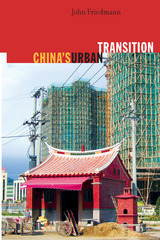 China's Urban Transition
John Friedmann
University of Minnesota Press, 2005 Though China's urban history reaches back over five thousand years, it is only in the last quarter century that urbanization has emerged as a force of widespread social transformation while a massive population shift from country to city has brought about a dramatic revolution in China's culture, politics, and economy. Employing a historical perspective, John Friedmann presents a succinct, readable account and interpretation of how this transition - one of the most momentous phenomena in contemporary history - has occurred. China's Urban Transition synthesizes a broad array of research to provide the first integrated treatment of the many processes that encompass the multi-layered meaning of urbanization: regional policy, the upsurge of rural industries, migration, expanding spheres of personal autonomy, and the governance of city building. John Friedmann's detailed analysis suggests that the nation's economic development has been driven more by social forces from within than by global capital. This leads directly to the epic story of rural migration to major urban regions, the policies used to restrain and direct this "avalanche" of humanity on the move, and the return of many migrants to their home communities, where the process of urbanization continues. Focusing on everyday life in cities, he also shows how this social transformation extends to the most intimate spheres of people's lives. In conclusion, the author raises the question of a "sustainable" urban development and its relation with China's own past, values, and institutions. Friedmann predicts that within ten years China - already the most powerful country in East Asia - will have become a major power in the world. With historical depth, interpretive insight, and interdisciplinary breadth, this book offers an unparalleled introduction to China's transformation.
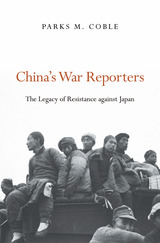 China’s War Reporters: The Legacy of Resistance against Japan
Parks M. Coble
Harvard University Press, 2015 When Japan invaded China in the summer of 1937, many Chinese journalists greeted the news with euphoria. For years, the Chinese press had urged Chiang Kai-shek to resist Tokyo’s aggressive overtures. This was the war they wanted, convinced that their countrymen would triumph.
Parks Coble recaptures the experiences of China’s war correspondents during the Sino–Japanese War of 1937–1945. He delves into the wartime writing of reporters connected with the National Salvation Movement—journalists such as Fan Changjiang, Jin Zhonghua, and Zou Taofen—who believed their mission was to inspire the masses through patriotic reporting. As the Japanese army moved from one stunning victory to the next, forcing Chiang’s government to retreat to the interior, newspaper reports often masked the extent of China’s defeats. Atrocities such as the Rape of Nanjing were played down in the press for fear of undercutting national morale.
By 1941, as political cohesion in China melted away, Chiang cracked down on leftist intellectuals, including journalists, many of whom fled to the Communist-held areas of the north. When the People’s Republic was established in 1949, some of these journalists were elevated to prominent positions. But in a bitter twist, all mention of their wartime writings disappeared. Mao Zedong emphasized the heroism of his own Communist Revolution, not the war effort led by his archrival Chiang. Denounced as enemies during the Cultural Revolution, once-prominent wartime journalists, including Fan, committed suicide. Only with the revival of Chinese nationalism in the reform era has their legacy been resurrected.
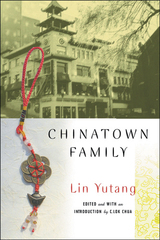 Chinatown Family
Yutang, Lin
Rutgers University Press, 2006 Lin Yutang (1895–1976), author of more than thirty-five books, was arguably the most distinguished Chinese American writer of the twentieth century. In Chinatown Family, he brings humor and wisdom to issues of culture, race, and religion as he tells the engrossing and heart-warming story of an immigrant, working-class Chinese American family that settled in New York City during the 1930s and 1940s. Tracing their sometimes troubled and sometimes rewarding journey, Lin paints a vivid portrait of the wonder and the woe of settling into a new land. In an era when interracial marriages were frowned upon and it was forbidden for working-class Chinese men to bring their families to America, this story shows how one family struggled to become new Americans by applying their Taoist philosophy to resist peacefully the discriminatory laws and racism they encountered.
Beyond the quest for acceptance and economic success, Chinatown Family also probes deep into the heart of the immigration experience by presenting the perils of assimilation. The burgeoning tensionbetween the desire for material wealth and the traditional Chinese belief in the primary importance of family poses the question: Is it possible to attain the American dream without damaging these primary ties? For each family member, the answer to this question turns out to be different. Through the varied paths that each character takes, the novel dramatizes the ways that Chinese immigrants have negotiated between the competing interests of economic opportunity and traditional values.
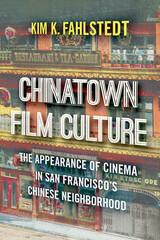 Chinatown Film Culture: The Appearance of Cinema in San Francisco’s Chinese Neighborhood
Kim K. Fahlstedt
Rutgers University Press, 2020 Chinatown Film Culture provides the first comprehensive account of the emergence of film and moviegoing in the transpacific hub of San Francisco in the early twentieth century. Working with materials previously left in the margins of grand narratives of history, Kim K. Fahlstedt uncovers the complexity of a local entertainment culture that offered spaces where marginalized Chinese Americans experienced and participated in local iterations of modernity. At the same time, this space also fostered a powerful Orientalist aesthetic that would eventually be exported to Hollywood by San Francisco showmen such as Sid Grauman. Instead of primarily focusing on the screen-spectator relationship, Fahlstedt suggests that immigrant audiences' role in the proliferation of cinema as public entertainment in the United States saturated the whole moviegoing experience, from outside on the street to inside the movie theater. By highlighting San Francisco and Chinatown as featured participants rather than bit players, Chinatown Film Culture provides an historical account from the margins, alternative to the more dominant narratives of U.S. film history.
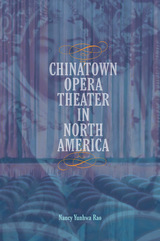 Chinatown Opera Theater in North America
Nancy Yunhwa Rao
University of Illinois Press, 2017 Awards: Irving Lowens Award, Society for American Music (SAM), 2019 Music in American Culture Award, American Musicological Society (AMS), 2018 Certificate of Merit for Best Historical Research in Recorded Country, Folk, Roots, or World Music, Association for Recorded Sound Collections (ARSC), 2018 Outstanding Achievement in Humanities and Cultural Studies: Media, Visual, and Performance Studies, Association for Asian American Studies (AAAS), 2019 The Chinatown opera house provided Chinese immigrants with an essential source of entertainment during the pre–World War II era. But its stories of loyalty, obligation, passion, and duty also attracted diverse patrons into Chinese American communities Drawing on a wealth of new Chinese- and English-language research, Nancy Yunhwa Rao tells the story of iconic theater companies and the networks and migrations that made Chinese opera a part of North American cultures. Rao unmasks a backstage world of performers, performance, and repertoire and sets readers in the spellbound audiences beyond the footlights. But she also braids a captivating and complex history from elements outside the opera house walls: the impact of government immigration policy; how a theater influenced a Chinatown's sense of cultural self; the dissemination of Chinese opera music via recording and print materials; and the role of Chinese American business in sustaining theatrical institutions. The result is a work that strips the veneer of exoticism from Chinese opera, placing it firmly within the bounds of American music and a profoundly American experience.
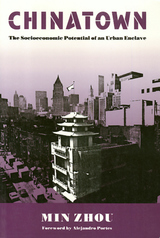 Chinatown: The Socioeconomic Potential of an Urban Enclave
Min Zhou, foreword by Alejandro Portes
Temple University Press, 1995 Min Zhou examines how an ethnic enclave works to direct its members into American society, while at the same time shielding them from it. Focusing specifically on New York's Chinatown, a community established more than a century ago, Zhou offers a thorough and modern treatment of the enclave as a socioeconomic system, distinct form, but intrinsically linked with, the larger society. Zhou's central theme is that Chinatown does not keep immigrant Chinese from assimilating into mainstream society, but instead provides an alternative means of incorporation into society that does not conflict with cultural distinctiveness. Concentrating on the past two decades, Zhou maintains that community networks and social capital are important resources for reaching socioeconomic goals and social positions in the United States; in Chinatown, ethnic employers use family ties and ethnic resources to advance socially. Relying on her family's networks in New York's Chinatown and her fluency in both Cantonese and Mandarin, the author, who was born in the People's Republic of China, makes extensive use of personal interviews to present a rich picture of the daily work life in the community. She demonstrates that for many immigrants, low-paid menial jobs provide by the enclave are expected as a part of the time-honored path to upward social mobility of the family. In the series Conflicts in Urban and Regional Development, edited by John R. Logan and Todd Swanstrom.
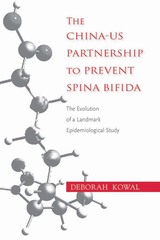 The China-US Partnership to Prevent Spina Bifida: The Evolution of a Landmark Epidemiological Study
Deborah Kowal
Vanderbilt University Press, 2015 In 1983 two doctors, one from each side of the world, decided to form a partnership, and so began a scientific adventure that would improve the odds that babies could be born healthy and whole. Neural tube defects that severely disabled or killed babies were epidemic in China (where the folk term was guai tai--roughly "monster baby"--for an infant whose embryonic neural tube doesn't completely close and whose head and neck may be misshapen or spine may protrude) and a significant problem in the United States, leading teams of researchers from the United States and China to combine forces to recruit more than 285,000 Chinese women and to follow nearly 250,000 pregnancies in an epidemiological study. Sixteen thousand staff were involved in running the project, which encountered massive bureaucratic obstacles as well as cultural differences, politicking for study designs and funding, the crisis of Tiananmen Square, and testy debates over research ethics. Nevertheless, the researchers persevered in a collaboration that lasted more than three decades and led to landmark findings on the role of folic acid in preventing spina bifida. Fortifying cereal grain products with folic acid became routine in the United States and a growing number of nations around the world: that intervention was named one of the ten great public health achievements of the last decade.
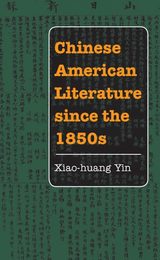 Chinese American Literature since the 1850s
Xiao-huang Yin
University of Illinois Press, 2000 The writings of immigrants from China and their descendants in the United States reflect the changes and continuity in the Chinese American experience. Xiao-huang Yin combines literary and historical scholarship to trace the origins and development of this extensive, neglected body of literature. Chinese American Literature since the 1850s covers representative works from the 1850s to the present. Selections include journalism and autobiography by nineteenth-century Chinese authors; writings on the walls of Angel Island, the main Asian immigrant arrival point on the West Coast; writings of late-nineteenth and early-twentieth-century "cultivated Chinese," students and scholars who came to America to advance their educations; important writing by immigrants such as Chen Ruoxi, Yu Lihua, and Zhang Xiguo; and the works of more recent authors like Sui Sin Far, Jade Snow Wong, Frank Chin, Maxine Hong Kingston, and Amy Tan. An essential introduction and guide to the field, Chinese American Literature since the 1850s enlarges the available body of literature and provides new insights into the Chinese American immigrant experience and the writing inspired by it.
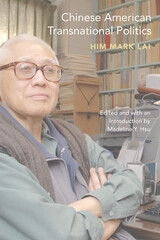 Chinese American Transnational Politics
Him Mark Lai, Edited and with an Introduction by Madeline Y. Hsu
University of Illinois Press, 2010 Born and raised in San Francisco, Lai was trained as an engineer but blazed a trail in the field of Asian American studies. Long before the field had any academic standing, he amassed an unparalleled body of source material on Chinese America and drew on his own transnational heritage and Chinese patriotism to explore the global Chinese experience. In Chinese American Transnational Politics, Lai traces the shadowy history of Chinese leftism and the role of the Kuomintang of China in influencing affairs in America. With precision and insight, Lai penetrates the overly politicized portrayals of a history shaped by global alliances and enmities and the hard intolerance of the Cold War era. The result is a nuanced and singular account of how Chinese politics, migration to the United States, and Sino-U.S. relations were shaped by Chinese and Chinese American groups and organizations. Lai revised and expanded his writings over more than thirty years as changing political climates allowed for greater acceptance of leftist activities and access to previously confidential documents. Drawing on Chinese- and English-language sources and echoing the strong loyalties and mobility of the activists and idealists he depicts, Lai delivers the most comprehensive treatment of Chinese transnational politics to date.
Chinese American Transnationalism: The Flow of People, Resources
Sucheng Chan
Temple University Press, 2005 Chinese American Transnationalism considers the many ways in which Chinese living in the United States during the exclusion era maintained ties with China through a constant interchange of people and economic resources, as well as political and cultural ideas. This book continues the exploration of the exclusion era begun in two previous volumes: Entry Denied, which examines the strategies that Chinese Americans used to protest, undermine, and circumvent the exclusion laws; and Claiming America, which traces the development of Chinese American ethnic identities. Taken together, the three volumes underscore the complexities of the Chinese immigrant experience and the ways in which its contexts changed over the sixty-one year period.
Chinese Americans and the Politics of Race and Culture
Sucheng Chan
Temple University Press, 2008 Sucheng Chan introduces this valuable new anthology with a commanding discussion of the field of Chinese American studies, in which she examines its history and points the way ahead. Here she and Madeline Y. Hsu have brought together leading-edge scholarship from a new generation of thinkers, as useful for scholars as it is for undergraduate readers. The contributors address a broad range of issues, from the activism of left-wing and Communist Chinese immigrants to the U.S. in the 1920s and early 1930s and humanitarian relief during the Sino-Japanese War to the construction of new Chinese regional identities in New York.
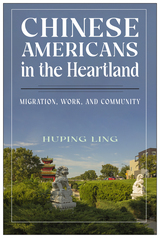 Chinese Americans in the Heartland: Migration, Work, and Community
Huping Ling
Rutgers University Press, 2022 The term “Heartland” in American cultural context conventionally tends to provoke imageries of corn-fields, flat landscape, hog farms, and rural communities, along with ideas of conservatism, homogeneity, and isolation. But as the Midwestern and Southern states experienced more rapid population growth than that in California, Hawaii, and New York in the recent decades, the Heartland region has emerged as a growing interest of Asian American studies. Focused on the Heartland cities of Chicago, Illinois and St. Louis, Missouri, this book draws rich evidences from various government records, personal stories and interviews, and media reports, and sheds light on the commonalities and uniqueness of the region, as compared to the Asian American communities on the East and West Coast and Hawaii. Some of the poignant stories such as “the Three Moy Brothers,” “Alla Lee,” and “Save Sam Wah Laundry” told in the book are powerful reflections of Asian American history.
The Chinese Americans, Revised Edition
Benson Tong
University Press of Colorado, 2003 This fully revised and redesigned edition traces the Chinese experience in the United States from the 1780s to the present, demonstrating that Chinese Americans have played an active role in shaping the history of our nation. This revised edition includes new material on children's history, transnationalism, and health care, and the author has expanded his original text and included more Chinese American voices.
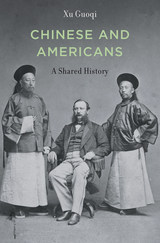 Chinese and Americans: A Shared History
Xu Guoqi
Harvard University Press, 2014 Chinese–American relations are often viewed through the prism of power rivalry and civilization clash. But China and America’s shared history is much more than a catalog of conflicts. Using culture rather than politics or economics as a reference point, Xu Guoqi highlights significant yet neglected cultural exchanges in which China and America have contributed to each other’s national development, building the foundation of what Zhou Enlai called a relationship of “equality and mutual benefit.”
Xu begins with the story of Anson Burlingame, Abraham Lincoln’s ambassador to China, and the 120 Chinese students he played a crucial role in bringing to America, inaugurating a program of Chinese international study that continues today. Such educational crosscurrents moved both ways, as is evident in Xu’s profile of the remarkable Ge Kunhua, the Chinese poet who helped spearhead Chinese language teaching in Boston in the 1870s. Xu examines the contributions of two American scholars to Chinese political and educational reform in the twentieth century: the law professor Frank Goodnow, who took part in making the Yuan Shikai government’s constitution; and the philosopher John Dewey, who helped promote Chinese modernization as a visiting scholar at Peking University and elsewhere. Xu also shows that it was Americans who first introduced to China the modern Olympic movement, and that China has used sports ever since to showcase its rise as a global power. These surprising shared traditions between two nations, Xu argues, provide the best roadmap for the future of Sino–American relations.
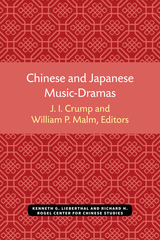 Chinese and Japanese Music-Dramas
J. I. Crump and William P. Malm, Editors
University of Michigan Press, 1975 Chinese and Japanese Music-Dramas is the result of a conference on the relations between Chinese and Japanese music-drama held at the University of Michigan, Ann Arbor, on October 1–4, 1971. In addition to the Association for Asian Studies, four U-M departments participated in the conference: the Center for Japanese Studies, the Center for Chinese Studies, the School of Music, and the Speech Department. One important inspiration for the creation of such an interdisciplinary conference was the fact that each participant had found, after years of individual research on music-drama in East Asia, consistent frustration caused by attempts to deal on their own with multiple cultural and technical problems. Another motivating force was an awareness among many members of the four disciplines involved that the topic is in fact one of the largest untouched fields of scholarly endeavor in both Asian and theatrical studies. The collection opens with J. I. Crump’s exploration of the Ming commentators who began to subject Yüan musical drama to the same critiques as other literature from the past. In the second chapter, Rulan Chao Pian looks to the structure of arias in Peking Opera for clues about what distinguishes this art form. William P. Malm turns to three key sources for the performance conventions of Japanese Noh drama to glean any Sino-Japanese music relationships that exist in technical terms and practices. In the fourth essay, Carl Sesar analyzes a Noh play that stages the tension between Chinese influence and Japanese originality. Roy E Teele concludes the volume with a formal study of Noh play structure to assess lineages of influence from Chinese dramatic forms. After each contribution, the editors print a transcript of the conference participants’ discussion of that paper, providing the reader with a detailed and nuanced view of how the contributors understood and responded to each other’s work.
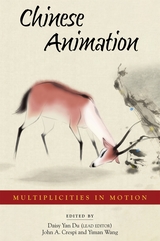 Chinese Animation: Multiplicities in Motion
Daisy Yan Du, John Crespi, and Yiman Wang
Harvard University Press, 2025 Chinese Animation: Multiplicities in Motion is the first edited volume that explores the multiple histories, geographies, industries, technologies, media, and transmedialities of Chinese animation, from early animated special effects to socialist classics, from computer-generated-imagery (CGI) blockbusters to edgy independent films, and from stop-motion to virtual reality.
Its fifteen chapters, grouped under the five themes of junctures, gender, identities, digitality, and practices, span a century of animation since the 1920s across mainland China, Hong Kong, Taiwan, Singapore, and the diasporic world. Derived from the 2021 Inaugural Conference of the Association for Chinese Animation Studies (ACAS), this volume as a whole defines Chinese animation studies as a new field of research emerging from the peripheries of modern Chinese literature and film studies on the one hand, and from the margins of Western and Japanese animation studies on the other. Incorporating diverse academic approaches and perspectives, this groundbreaking book is an indispensable guide for a rapidly growing community of scholars, students, animators, fans, and general readers interested in Chinese and world animation.
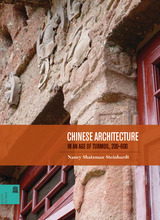 Chinese Architecture in an Age of Turmoil, 200-600
Nancy S. Steinhardt
University of Hawaii Press, 2014 Between the fall of the Han dynasty in 220 CE and the year 600, more than thirty dynasties, kingdoms, and states rose and fell on the eastern side of the Asian continent. The founders and rulers of those polities represented the spectrum of peoples in North, East, and Central Asia. Nearly all of them built palaces, altars, temples, tombs, and cities, and almost without exception, the architecture was grounded in the building tradition of China. Illustrated with more than 475 color and black-and-white photographs, maps, and drawings, Chinese Architecture in an Age of Turmoil uses all available evidence—Chinese texts, secondary literature in six languages, excavation reports, and most important, physical remains—to present the architectural history of this tumultuous period in China’s history. Its author, Nancy Shatzman Steinhardt, arguably North America’s leading scholar of premodern Chinese architecture, has done field research at nearly every site mentioned, many of which were unknown twenty years ago and have never been described in a Western language.
The physical remains are a handful of pagodas, dozens of cave-temples, thousands of tombs, small-scale evidence of architecture such as sarcophaguses, and countless representations of buildings in paint and relief sculpture. Together they narrate an expansive architectural history that offers the first in-depth study of the development, century-by-century, of Chinese architecture of third through the sixth centuries, plus a view of important buildings from the two hundred years before the third century and the resolution of architecture of this period in later construction. The subtext of this history is an examination of Chinese architecture that answers fundamental questions such as: What was achieved by a building system of standardized components? Why has this building tradition of perishable materials endured so long in China? Why did it have so much appeal to non-Chinese empire builders? Does contemporary architecture of Korea and Japan enhance our understanding of Chinese construction? How much of a role did Buddhism play in construction during the period under study? In answering these questions, the book focuses on the relation between cities and monuments and their heroic or powerful patrons, among them Cao Cao, Shi Hu, Empress Dowager Hu, Gao Huan, and lesser-known individuals. Specific and uniquely Chinese aspects of architecture are explained. The relevance of sweeping—and sometimes uncomfortable—concepts relevant to the Chinese architectural tradition such as colonialism, diffusionism, and the role of historical memory also resonate though the book.
 The Chinese Army After Mao
Ellis Joffe
Harvard University Press, 1987 Ellis Joffe has drawn on a lifetime of experience as an analyst of Chinese military affairs in this authoritative assessment of a highly elusive subject: military modernization and the politics of civilian-military relations in the post-Mao period. He has sifted vast amounts of evidence, primary and secondary, to show that during the past few years the Chinese army has been transformed into a relatively modern and professional force that will be the basis for future growth of China’s military power.
The author begins by describing the development of the People’s Liberation Army in the Maoist era and explains the reasons for its decline. He analyzes the political changes and the shifts in strategic outlook of Mao’s successors that have made possible a new policy of military modernization: a policy of raising the combat capability of the PLA through slow improvements of technology—including buying some material abroad—and a thorough upgrading of the nontechnological components of military power.
Joffe examines all aspects of the PLA’s modernization, focusing on the wide-ranging changes in doctrine, weapons, organization, structure, and modes of operation, and concludes with an analysis of the PLA’s political role and the state of civil–military relations. There is a particularly perspicacious chapter dissecting Deng’s maneuvers to remove the military influence in politics that had burgeoned during and after the Cultural Revolution.
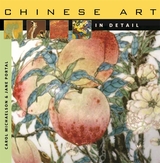 Chinese Art in Detail
Carol Michaelson and Jane Portal
Harvard University Press For many Westerners, the words "Chinese art" evoke visions of willow pattern landscapes on porcelain plates and teapots, Chinese wallpaper decorated with flowers, birds, and pagodas, and perhaps silk brocades. This beautiful book allows readers to see beyond such ornamental exports to the true nature of the art produced in China over millennia for a Chinese audience, whether the Emperor, the scholarly elite, the ordinary folk, or the furnishing of tombs and temples.
Drawing on the British Museum's extensive collection, Chinese Art in Detail explores the traditional hierarchy of materials and techniques reaching back as far as the Han Dynasty in the third century B.C.—with calligraphy and painting most revered, followed by jades and bronzes, decorative arts such as lacquer, porcelain, and silk, and, finally, sculpture for religious and funerary use. Images of complete artifacts set against magnified details give readers the rare opportunity to appreciate the delicacies of technique and material that characterize much of Chinese art—and distinguish one form, as well as one period, from another. Illuminated throughout by two scholars thoroughly and deeply versed in the history and character of the works under scrutiny, this sumptuously illustrated book conveys an understanding of Chinese art in all its great variety, its simplicities, its complexities, its splendors, and its mysteries of craft and inspiration reaching back to Neolithic times.
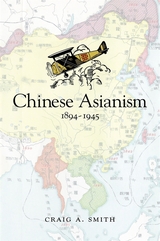 Chinese Asianism, 1894–1945
Craig A. Smith
Harvard University Press Chinese Asianism examines Chinese intellectual discussions of East Asian solidarity, analyzing them in connection with Chinese nationalism and Sino–Japanese relations. Beginning with texts written after the first Sino–Japanese War of 1894 and concluding with Wang Jingwei’s failed government in World War II, Craig Smith engages with a period in which the Chinese empire had crumbled and intellectuals were struggling to adapt to imperialism, new and hegemonic forms of government, and radically different epistemes. He considers a wide range of writings that show the depth of the pre-war discourse on Asianism and the influence it had on the rise of nationalism in China.
Asianism was a “call” for Asian unity, Smith finds, but advocates of a united and connected Asia based on racial or civilizational commonalities also utilized the packaging of Asia for their own agendas, to the extent that efforts towards international regionalism spurred the construction of Chinese nationalism. Asianism shaped Chinese ideas of nation and region, often by translating and interpreting Japanese perspectives, and leaving behind a legacy in the concepts and terms that persist in the twenty-first century. As China plays a central role in regional East Asian development, Asianism is once again of great importance today.
A Chinese Beggars' Den: Poverty and Mobility in an Underclass Community
David C. Schak
University of Pittsburgh Press, 1988 In this fascinating study of a community of Chinese beggars, David Schak offers evidence that challenges widely held theories on poverty. It is a path-breaking, systematic anthropological study that challenges long-held beliefs about poverty, and is one of the few works on beggars available.
Over a period of seven years, Schak's fieldwork uncovers a structure of leadership, organizational methods, and alms-getting tactics. Moreover, certain members became upwardly mobile and able to leave this lifestyle. The severe stigma of gambling, adultery, and failure to marry proved the stimulus for a younger generation to leave begging behind.
The Chinese Bell Murders
Robert van Gulik
University of Chicago Press, 1977 The Chinese Bell Murders describes the Judge's exploits in the tribunal of Poo-yang early in his career. He has one case left over from his predecessor—the brutal rape-murder of Pure Jade, the daughter of Butcher Hsai who lived on Half Moon Street. Her lover has been accused and is on the verge of being convicted, but Judge Dee senses that all is not right and sets out with his lieutenants to find the real murderer.
"So scrupulously in the classic Chinese manner yet so nicely equipped with everything to satisfy the modern reader."—New York Times
Robert Van Gulik (1910-67) was a Dutch diplomat and an authority on Chinese history and culture. He drew his plots from the whole body of Chinese literature, especially from the popular detective novels that first appeared in the seventeenth century.
 Chinese Business in the Making of a Malay State, 1882-1941: Kedah and Penang
Wu Xiao An
National University of Singapore Press, 2010 The Chinese in colonial Malaya were noted for their involvement in revenue farming, the rice trade, mining and estates, and pawnbroking. However, the Chinese presence was also significant in broader economic and social spheres, and the wealth and power of the Chinese community helped fuel the emerging colonial state and the modern transformation of Southeast Asia. In Chinese Business in the Making of a Malay State, Wu Xiao An argues persuasively that Chinese ventures owed much of their success to the flexibility and dynamism of Chinese family and economic networks, and the moral imperatives that governed relationships within the Chinese community.
Using Penang and Kedah as a case study, Wu draws on archival sources, family histories and an examination of legal arrangements and the press to show that personal business and business networks were not bound by the territorial borders of traditional or modern states, but extended across much of Southeast Asia and into China. His demonstration of the complexity of interactions involving new migrants, sojourners and settlers, both Chinese and non-Chinese, challenges understandings of state formation and economic growth in colonial Malaya based on ethnic stereotypes and accounts of events limited by fixed political boundaries.
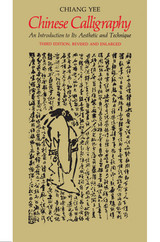 Chinese Calligraphy: An Introduction to Its Aesthetic and Technique, Third Revised and Enlarged Edition
Yee Chiang
Harvard University Press, 1974 Chiang Yee’s Chinese Calligraphy: An Introduction to Its Aesthetic and Technique remains the classic introduction to Chinese calligraphy. In eleven richly illustrated chapters, Chiang explores the aesthetics and the technique of this art in which rhythm, line, and structure are perfectly embodied. He measures the slow change from pictograph to stroke to the style and shape of written characters by the great calligraphers.
In addition to aesthetic considerations, the text deals with more practical subjects such as the origin and construction of the Chinese characters, styles, technique, strokes, composition, training, and the relations between calligraphy and other forms of Chinese art.
Chinese Calligraphy is a superb appreciation of beauty in the movement of strokes and in the patterns of structure—and an inspiration to amateurs as well as professionals interested in the decorative arts.
Chinese "Cancer Villages": Rural Development, Environmental Change and Public Health
Ajiang Chen
Amsterdam University Press, 2020 The phenomenon of "cancer villages" has emerged in many parts of rural China, drawing media attention and becoming a fact of social life. However, the relationship between pollution and disease is often hard to discern. Through sociological analysis of several villages with different social and economic structures, the authors offer a comprehensive, historically grounded analysis of the coexistence between the incidence of cancer, environmental pollution and villagers’ lifestyles, as well as the perceptions, claims and responses of different actors. They situate the appearance of "cancer villages" in the context of social, economic and cultural change in China, tracing the evolution of the issue over two decades, and providing deep insights into the complex interactions and trade-offs between economic growth, environmental change and public health.
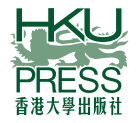 Chinese Cinema: Identity, Power, and Globalization
Edited by Jeff Kyong-McClain, Russell Meeuf, and Jing Jing Chang
Hong Kong University Press, 2022 A pioneer investigation of Chinese cinema and the Chinese film industry.
In Chinese Cinema: Identity, Power, and Globalization, a variety of scholars explore the history, aesthetics, and politics of Chinese cinema as the Chinese film industry grapples with its place as the second-largest film industry in the world. Exploring the various ways that Chinese cinema engages with global politics, market forces, and film cultures, this edited volume places Chinese cinema against an array of contexts informing the contours of Chinese cinema today. The book also demonstrates that Chinese cinema in the global context is informed by the intersections and tensions found in Chinese and world politics, national and international co-productions, the local and global in representing Chineseness, and the lived experiences of social and political movements versus screened politics in Chinese film culture.
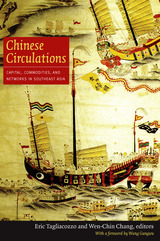 Chinese Circulations: Capital, Commodities, and Networks in Southeast Asia
Eric Tagliacozzo and Wen-Chin Chang, eds.
Duke University Press, 2011 Chinese merchants have traded with Southeast Asia for centuries, sojourning and sometimes settling, during their voyages. These ventures have taken place by land and by sea, over mountains and across deserts, linking China with vast stretches of Southeast Asia in a broad, mercantile embrace. Chinese Circulations provides an unprecedented overview of this trade, its scope, diversity, and complexity. This collection of twenty groundbreaking essays foregrounds the commodities that have linked China and Southeast Asia over the centuries, including fish, jade, metal, textiles, cotton, rice, opium, timber, books, and edible birds’ nests. Human labor, the Bible, and the coins used in regional trade are among the more unexpected commodities considered. In addition to focusing on a certain time period or geographic area, each of the essays explores a particular commodity or class of commodities, following its trajectory from production, through exchange and distribution, to consumption. The first four pieces put Chinese mercantile trade with Southeast Asia in broad historical perspective; the other essays appear in chronologically ordered sections covering the precolonial period to the present. Incorporating research conducted in Chinese, Japanese, Vietnamese, Thai, Burmese, Malay, Indonesian, and several Western languages, Chinese Circulations is a major contribution not only to Sino-Southeast Asian studies but also to the analysis of globalization past and present. Contributors. Leonard Blussé, Wen-Chin Chang, Lucille Chia, Bien Chiang, Nola Cooke, Jean DeBernardi, C. Patterson Giersch, Takeshi Hamashita, Kwee Hui Kian, Li Tana, Lin Man-houng, Masuda Erika, Adam McKeown, Anthony Reid , Sun Laichen, Heather Sutherland, Eric Tagliacozzo, Carl A. Trocki, Wang Gungwu, Kevin Woods, Wu Xiao
 Chinese Communism and the Rise of Mao
Benjamin I. Schwartz
Harvard University Press Communistic doctrine and Communist leadership as they developed in China, and their changing relations to the Kremlin, are the subjects of this documented, readable—and controversial—book. Benjamin Schwartz points out that we have witnessed in China not only an elemental upsurge of the masses, but also the rise to power of a vigorous new ruling group basing itself on a forceful new strategy neither planned in advance nor anticipated by the Kremlin.
Schwartz studies the beginnings of Communism in China. He then analyzes the peculiar nature of the Communist-Kuomintang alliance of 1924 and the cause of its collapse, and discusses the role played by Mao Tse-tung during these years. He goes on to trace the growing isolation of the Chinese Communist Party from the urban proletariat; the shift of power to Mao Tse-tung in the countryside; and the emergence of a new strategy whose relation to the Kremlin's party line is more a matter of faith than of fact. For, under the leadership of Mao, the Chinese Party, while firmly convinced of its own orthodoxy, came to realize in the face of Marxist-Leninist doctrine that the peasantry could provide the mass basis and the motive power for a revolutionary transformation—and acted on that belief. The nature and extent of “'Titoism”' in China and elsewhere is the subject of Schwartz' thought-provoking final chapter.
Chinese Communist Materials at the Bureau of Investigation Archives, Taiwan
Peter Donovan, Carl E. Dorris, and Lawrence R. Sullivan
University of Michigan Press, 1976 During the long years of civil strife in China the Nationalist authorities amassed extensive materials on their Communist adversaries. Now stored in government institutions on Taiwan, these materials are an excellent source for the study of the Chinese Communist movement. Among them is the Bureau of Investigation Collection (BIC), which holds over 300,000 volumes of primary documents on the Chinese Communist movement. The purpose of Chinese Communist Materials is, without any attempt at comprehensive listing of the Bureau’s holdings, to give scholars a representative description of the collection, to point out its implications for research, and suggest new areas for research at the Bureau in the fields of political science and history [1, 4].
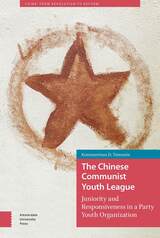 The Chinese Communist Youth League: Juniority and Responsiveness in a Party Youth Organization
Konstantinos Tsimonis
Amsterdam University Press, 2021 The Chinese Communist Youth League is the largest youth political organization in the world, with over 80 million members. Former Chinese President Hu Jintao was a firm supporter of the League, and believed that it could play a bigger role in winning the hearts and minds of Chinese youth by actively engaging with their interests and demands. Accordingly, he provided the League with a new youth work mandate to increase its capacity for responsiveness under the slogan 'keep the Party assured and the youth satisfied'. This original investigation of the hitherto-unexamined organization uses a combination of interviews, surveys and ethnography to explore how the League implemented Hu's mandate at both local and national levels, exposing the contradictory nature of some of its campaigns. By doing so, it also sheds light on the reasons for Xi Jinping's turn against the League during his first term in office.
The Chinese Communist Youth League: Juniority and Responsiveness in a Party Youth Organization develops the original concept of 'juniority' to capture the complex ways that generational power is institutionalized, alienating young people from official political processes, with significant implications for China's political development. The book will be of interest to researchers and students of Chinese politics, as well as to scholars of comparative youth politics and sociology.
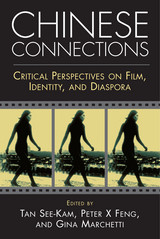 Chinese Connections: Critical Perspectives on Film, Identity, and Diaspora
Gina Marchetti
Temple University Press, 2009 Chinese Connections is a valuable new anthology that provides a prismatic look at the cross-fertilization between Chinese film and global popular culture. Leading film scholars consider the influence of world cinema on China-related and Chinese-related cinema over the last five decades. Highlighting the neglected connections between Chinese films and American and European cinema, the editors and contributors examine popular works such as Ang Lee’s The Hulk and Olivier Assayas’ Irma Vep to show the nexus of international film production and how national, political, social and sexual identities are represented in the Chinese diaspora. With talent flowing back and forth between East and West, Chinese Connections explores how issues of immigration, class, race and economic displacement are viewed on a global level, ultimately providing a greater understanding of the impact of Chinese filmmaking at home and abroad. Contributors include: Grace An, Aaron Anderson, Chris Berry, Evans Chan, Li-Mei Chang, Frances Gateward, Andrew Grossman, Peter Hitchcock, Chuck Kleinhans, Jenny Kwok Wah Lau, Helen Leung, Aaron Magnan-Park, Gayle Wald, Esther C.M. Yau, Emilie Yueh-yu Yeh, Xuelin Zhou and the editors.
 Chinese Dance: National Movements in a Revolutionary Age
Liangyu Fu & Emily Wilcox
Michigan Publishing, 2019 This book documents and expands upon the exhibition “Chinese Dance: National Movements in a Revolutionary Age, 1945-1965,” which was on display at the Hatcher Library at the University of Michigan in the Spring of 2017. Emily Wilcox and Liangyu Fu co-curated this exhibition to showcase the Asia Library’s recently formed Chinese Dance Collection, which is currently the largest of its kind in North America. Drawing upon Wilcox’s expertise as a leading scholar of Chinese dance studies, the book contextualizes the University of Michigan Collection’s materials and offers an accessibly written, concise, and richly illustrated introduction to a foundational period of modern Chinese dance history. The book links dance to issues of race, ethnicity, gender, and class. It also details previously unknown stories of individual dancers and choreographers and explores relationships among dance, popular media, and global exchange.
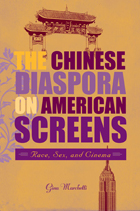 The Chinese Diaspora on American Screens: Race, Sex, and Cinema
Gina Marchetti
Temple University Press, 2012 The Chinese Diaspora on American Screens looks at the way in which issues of race and sexuality have become central concerns in cinema generated by and about Chinese communities in America after the mid-1990s. This companion volume to Marchetti's From Tian'anmen to Times Square looks specifically at the Chinese diaspora in relation to ethnic, racial, gender, and sexual identity as depicted in the cinema.
Examining films from the United States and Canada, as well as transnational co-productions, The Chinese Diaspora on American Screens includes analyses of films such as The Wedding Banquet and Double Happiness in addition to interviews with celebrated filmmakers such as Wayne Wang.
Marchetti also reflects on how Chinese identity is presented in a multitude of media forms, including commercial cinema, documentaries, experimental films, and hybrid digital media to offer a textured look at representations of the Chinese diasporic experience after Tian'anmen.
Chinese Domestic Politics and Foreign Policy in the 1970s
Allen S. Whiting
University of Michigan Press, 1979 Chinese Domestic Politics and Foreign Policy in the 1970s undertakes a systematic examination of selected aspects of Peking’s foreign policy, using content analysis, both quantitative and qualitative, of the media. The first study treats media images of the United States and Taiwan in 1976–77; the second analyzes domestic politics and foreign trade, 1971–1976. [1, 2]
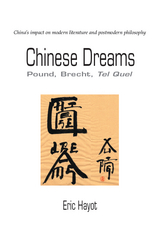 Chinese Dreams: Pound, Brecht, Tel Quel
Eric Hayot
University of Michigan Press, 2011 China’s profound influence on the avant-garde in the 20th century was nowhere more apparent than in the work of Ezra Pound, Bertolt Brecht, and the writers associated with the Parisian literary journal Tel quel. Chinese Dreams explores the complex, intricate relationship between various “Chinas”—as texts—and the nation/culture known simply as “China”—their context—within the work of these writers. Eric Hayot calls into question the very means of representing otherness in the history of the West and ultimately asks if it might be possible to attend to the political meaning of imagining the other, while still enjoying the pleasures and possibilities of such dreaming. The latest edition of this critically acclaimed book includes a new preface by the author. “Lucid and accessible . . . an important contribution to the field of East-West comparative studies, Asian studies, and modernism.”
—Comparative Literature Studies “Instead of trying to decipher the indecipherable ‘China’ in Western literary texts and critical discourses, Hayot chose to show us why and how ‘China’ has remained, and will probably always be, an enchanting, ever-elusive dream. His approach is nuanced and refreshing, his analysis rigorous and illuminating.”
—Michelle Yeh, University of California, Davis
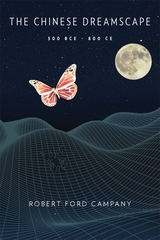 The Chinese Dreamscape, 300 BCE–800 CE
Robert Ford Campany
Harvard University Press, 2020 Winner of the Stanislas Julien Prize
Winner of the Joseph Levenson Prize for Scholarship on Pre-1900 China
Dreaming is a near-universal human experience, but there is no consensus on why we dream or what dreams should be taken to mean. In this book, Robert Ford Campany investigates what people in late classical and early medieval China thought of dreams. He maps a common dreamscape—an array of ideas about what dreams are and what responses they should provoke—that underlies texts of diverse persuasions and genres over several centuries. These writings include manuals of dream interpretation, scriptural instructions, essays, treatises, poems, recovered manuscripts, histories, and anecdotes of successful dream-based predictions.
In these many sources, we find culturally distinctive answers to questions peoples the world over have asked for millennia: What happens when we dream? Do dreams foretell future events? If so, how might their imagistic code be unlocked to yield predictions? Could dreams enable direct communication between the living and the dead, or between humans and nonhuman animals? The Chinese Dreamscape, 300 BCE–800 CE sheds light on how people in a distant age negotiated these mysteries and brings Chinese notions of dreaming into conversation with studies of dreams in other cultures, ancient and contemporary. Taking stock of how Chinese people wrestled with—and celebrated—the strangeness of dreams, Campany asks us to reflect on how we might reconsider our own notions of dreaming.
 Chinese Elites and Political Change: Zheijang Province in the Early Twentieth Century
R. Keith Schoppa
Harvard University Press, 1982 With the Qing Dynasty reform efforts (1901–1911), abolition of the civil service examination (1905), and the end of the monarchy (1912), the first three decades of the twentieth century brought important changes to the elite of Zhejiang Province. This book examines the social backgrounds, public activities, careers, and decision-making of local and provincial elites—that is, nonprofessional men who had taken on public duties when the multiplying problems of government had resulted in a general breakdown of public functions.
While elites in early twentieth-century China have often been caricatured as militarists, corrupt bureaucrats, evil landlords, and ineffectual reformers, they have not been clearly understood or closely analyzed. Since the seventeenth century, elites had been assuming increasing responsibility for funding and managing public projects, and by the twentieth century had expanded their activities still further. In the first three decades of the century, they experienced substantial personal and communitarian development; it was the structures and processes developed by these elites that subsequent regimes—Guomindang, Japanese, or Communist—had to build upon and adapt.
Keith Schoppa divides the counties of Zhejiang Province into four zones according to level of political and economic development and scrupulously analyzes the complex processes of remolding society at the local and provincial levels. By delving beneath the heroic figures and large movements of Chinese political life in this century, he reveals the common factors that make China a part of the worldwide story of reconstruction, reform, and developmental change.
Chinese Engagement in Africa: Drivers, Reactions, and Implications for U.S. Policy
Larry Hanauer
RAND Corporation, 2014 Examines Chinese engagement with African nations, focusing on (1) Chinese and African objectives in the political and economic spheres and how they work to achieve them, (2) African perceptions of Chinese engagement, (3) how China has adjusted its policies to accommodate African views, and (4) whether the United States and China are competing for influence, access, and resources in Africa and how they might cooperate in the region.
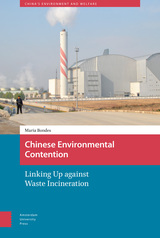 Chinese Environmental Contention: Linking Up against Waste Incineration
Maria Bondes
Amsterdam University Press, 2020 A plethora of new actors has in recent years entered China’s environmental arena. In Western countries, the linkages and diffusion processes between such actors often drive environmental movements. Through a study of Chinese anti-incineration contention, *Chinese Environmental Contention: Linking Up against Waste Incineration* investigates how the different contentious actors in China’s green sphere link up, and what this means for environmental contention. It addresses questions such as: What lies behind the notable increase of environmental protests in China? And what are the potentials for the emergence of an environmental movement? The book shows that a complex network of ties has emerged in China’s environmental realm under Hu Jintao. Affected communities across the country have connected with each other and with national-level environmentalists, experts and lawyers. Such networked contention fosters both local campaigns and national-level policy advocacy. Beyond China, the detailed case studies shed light on the dynamics behind the diffusion of contention under restrictive political conditions.
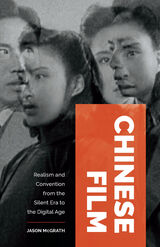 Chinese Film: Realism and Convention from the Silent Era to the Digital Age
Jason McGrath
University of Minnesota Press, 2022 A tour de force chronicling the development of realism in Chinese cinema
The history of Chinese cinema is as long and complicated as the tumultuous history of China itself. Be it the silent, the Communist, or the contemporary, each Chinese cinematic era has necessitated its own form in conversation with broader trends in politics and culture. In Chinese Film, Jason McGrath tells this fascinating story by tracing the varied claims to cinematic realism made by Chinese filmmakers, officials, critics, and scholars. Understanding realism as a historical dynamic that is both enabled and mitigated by aesthetic conventions of the day, he analyzes it across six different types of claims: ontological, perceptual, fictional, social, prescriptive, and apophatic. Through this method, McGrath makes major claims not just about Chinese cinema but also about realism as an aesthetic form that negotiates between cultural conventions and the ever-evolving real. He comes to envision it as more than just a cinematic question, showing how the struggle for realism is central to the Chinese struggle for modernity itself.
The Chinese from Indonesia: The History of a Minority
Patricia Tjiook-Liem
Amsterdam University Press, 2024 The Chinese played a vital part in the Dutch colonial economy, and their economic role has remained important throughout the centuries. Starting in the early 1900s, China also influenced their socio-political life. After the Chinese in the Dutch East Indies managed to shed most discriminatory regulations in the first decades of the twentieth century, they again had to strive for their rights in the new Republic of Indonesia. This proved to be a difficult process filled with tension surrounding the issues of culture, ethnicity and nationality. In this book, Patricia Tjiook-Liem puts Chinese Indonesians at the centre of Dutch colonial and Indonesian history, and takes you through the most important periods in this often underexposed history.
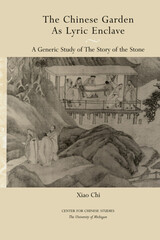 The Chinese Garden as Lyric Enclave: A Generic Study of The Story of the Stone
Chi Xiao
University of Michigan Press, 2012 Lyricism in poetry dominated the Chinese literary tradition for three millenia. Lyric aesthetics captured the world in verse, and compelled people to seek the totalistic behind the contingent, the abiding behind the fluid, and the perfect behind the incomplete. The development of the novel and the cultural milieu that produced it, however, rendered this lyric ideal more prosaic, both in everyday life and in literature. The Chinese Garden as Lyric Enclave places The Story of the Stone in relation to this history. Read as an allegory of the fate of lyricism, The Stone is a parodic response to both the lyrical phenomena in the literary and social worlds and the cosmological beliefs on which Chinese lyricism is based. Thus we can trace the social life of lyricism through different cultural zones: the world where the novel was produced, the world of fiction, and the narrative universe of the story itself. The garden, in both the novel and cultural tradition, is a link between all three zones. Chi Xiao breaks new ground in understanding The Story of the Stone, blending his extensive knowledge of traditional Chinese fiction with a remarkably crafted history of the garden as an enduring feature of elite Chinese life. By focusing on the role of the garden in The Stone, Xiao Chi reveals the special linkages between the world of fiction, the world that produced the novel, and the narrative universe of the story itself.
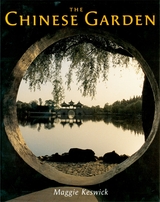 The Chinese Garden: History, Art and Architecture, Third Edition
Maggie Keswick
Harvard University Press, 2003 Dense with winding paths, dominated by huge rock piles and buildings squeezed into small spaces, the characteristic Chinese garden is, for many foreigners, so unlike anything else as to be incomprehensible. Only on closer acquaintance does it offer up its mysteries; and such is the achievement of Maggie Keswick's celebrated classic that it affords us--adventurers, armchair travelers, and garden buffs alike--the intimate pleasures of the Chinese garden.
In these richly illustrated pages, Chinese gardens unfold as cosmic diagrams, revealing a profound and ancient view of the world and of humanity's place in it. First sensuous impressions give way to more cerebral delights, and forms conjure unending, increasingly esoteric and mystical layers of meaning for the initiate. Keswick conducts us through the art and architecture, the principles and techniques of Chinese gardens, showing us their long history as the background for a civilization--the settings for China's great poets and painters, the scenes of ribald parties and peaceful contemplation, political intrigues and family festivals.
Updated and expanded in this third edition, with an introduction by Alison Hardie, many new illustrations, and an updated list of gardens in China accessible to visitors, Keswick's engaging work remains unparalleled as an introduction to the Chinese garden.
Chinese Heritage in the Making: Experiences, Negotiations and Contestations
Edited by Christina Maags and Marina Svensson
Amsterdam University Press, 2018 The Chinese state uses cultural heritage as a source of power by linking it to political and economic goals, but heritage discourse has at the same time encouraged new actors to appropriate the discourse to protect their own traditions. This book focuses on that contested nature of heritage, especially through the lens of individuals, local communities, religious groups, and heritage experts. It examines the effect of the internet on heritage-isation, as well as how that process affects different groups of people.
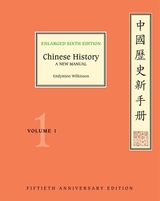 Chinese History
Endymion Wilkinson
Harvard University Press, 2022 Endymion Wilkinson’s bestselling Chinese History: A New Manual has been continuously in print for fifty years. It has achieved this unusual distinction because the author expanded its scope with each new edition. In the process it has grown from a modest research guide to Chinese imperial history into an encyclopedic, 1.7-million-word introduction to Chinese civilization and the primary and secondary resources and research problems for all periods of Chinese history. In recognition of its unique value, the Académie des Inscriptions et Belles-Lettres (France) awarded the third edition the Stanislas Julien Prize, and in 2016, Peking University Press published the entire Manual in a three-volume Chinese edition.
The sixth edition of the Manual has been revised and expanded throughout to include the latest developments in digital tools and the two dozen ancillary disciplines essential for work on Chinese history. In addition, its temporal coverage has been extended to the death of Chairman Mao.
In celebration of a half century of continuous publication, the enlarged sixth edition consists of two volumes. Volume 1 covers topics ranging from Language, Education, and the Arts to Science, Technology, and the Environment. Volume 2 presents primary and secondary sources chronologically by period from the Neolithic to 1976.
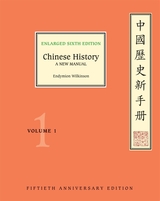 Chinese History
Endymion Wilkinson
Harvard University Press, 2022 Endymion Wilkinson’s bestselling Chinese History: A New Manual has been continuously in print for fifty years. It has achieved this unusual distinction because the author expanded its scope with each new edition. In the process it has grown from a modest research guide to Chinese imperial history into an encyclopedic, 1.7-million-word introduction to Chinese civilization and the primary and secondary resources and research problems for all periods of Chinese history. In recognition of its unique value, the Académie des Inscriptions et Belles-Lettres (France) awarded the third edition the Stanislas Julien Prize, and in 2016, Peking University Press published the entire Manual in a three-volume Chinese edition.
The sixth edition of the Manual has been revised and expanded throughout to include the latest developments in digital tools and the two dozen ancillary disciplines essential for work on Chinese history. In addition, its temporal coverage has been extended to the death of Chairman Mao.
In celebration of a half century of continuous publication, the enlarged sixth edition consists of two volumes. Volume 1 covers topics ranging from Language, Education, and the Arts to Science, Technology, and the Environment. Volume 2 presents primary and secondary sources chronologically by period from the Neolithic to 1976.
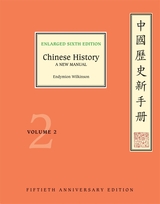 Chinese History
Endymion Wilkinson
Harvard University Press, 2022 Endymion Wilkinson’s bestselling Chinese History: A New Manual has been continuously in print for fifty years. It has achieved this unusual distinction because the author expanded its scope with each new edition. In the process it has grown from a modest research guide to Chinese imperial history into an encyclopedic, 1.7-million-word introduction to Chinese civilization and the primary and secondary resources and research problems for all periods of Chinese history. In recognition of its unique value, the Académie des Inscriptions et Belles-Lettres (France) awarded the third edition the Stanislas Julien Prize, and in 2016, Peking University Press published the entire Manual in a three-volume Chinese edition.
The sixth edition of the Manual has been revised and expanded throughout to include the latest developments in digital tools and the two dozen ancillary disciplines essential for work on Chinese history. In addition, its temporal coverage has been extended to the death of Chairman Mao.
In celebration of a half century of continuous publication, the enlarged sixth edition consists of two volumes. Volume 1 covers topics ranging from Language, Education, and the Arts to Science, Technology, and the Environment. Volume 2 presents primary and secondary sources chronologically by period from the Neolithic to 1976.
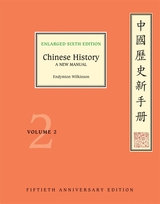 Chinese History
Endymion Wilkinson
Harvard University Press, 2022 Endymion Wilkinson’s bestselling Chinese History: A New Manual has been continuously in print for fifty years. It has achieved this unusual distinction because the author expanded its scope with each new edition. In the process it has grown from a modest research guide to Chinese imperial history into an encyclopedic, 1.7-million-word introduction to Chinese civilization and the primary and secondary resources and research problems for all periods of Chinese history. In recognition of its unique value, the Académie des Inscriptions et Belles-Lettres (France) awarded the third edition the Stanislas Julien Prize, and in 2016, Peking University Press published the entire Manual in a three-volume Chinese edition.
The sixth edition of the Manual has been revised and expanded throughout to include the latest developments in digital tools and the two dozen ancillary disciplines essential for work on Chinese history. In addition, its temporal coverage has been extended to the death of Chairman Mao.
In celebration of a half century of continuous publication, the enlarged sixth edition consists of two volumes. Volume 1 covers topics ranging from Language, Education, and the Arts to Science, Technology, and the Environment. Volume 2 presents primary and secondary sources chronologically by period from the Neolithic to 1976.
Chinese History: A Manual, First Edition
Endymion Wilkinson
Harvard University Press, 1998 THIS EDITION HAS BEEN REPLACED BY A NEWER EDITION.
A comprehensive and up-to-date guide on the basic problems encountered in researching traditional Chinese civilization and history, this manual includes discussions of over 1,000 primary sources as well as 1,000 reference works. The first part covers the basics of language, geography, dates, time, statistics, and primary sources. The second part treats primary sources, such as archives, legal codes, literature, and science. The third part lists key sources by historical period, from the pre-Qin period through the Qing.
Chinese History: A Manual, Revised and Enlarged Edition
Endymion Wilkinson
Harvard University Press, 2000 Since publication of the first edition in 1998, Chinese History: A Manual has become an indispensable guide to researching the civilization and history of China. Updated through January 2000, the second edition discusses some 4,300 primary, secondary, and reference works, an increase of 1,500 titles over the first edition. The temporal coverage has been expanded to include the Republican period; sections on nonverbal salutations, weights and measures, money, and furniture have been added; the chapters on language, etymology, people, geography, chronology, warfare, leishu, food, and the Chinese world order have been thoroughly revised; and the subject index has been enlarged to include 2,500 technical terms.
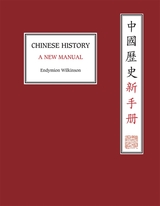 Chinese History: A New Manual
Endymion Wilkinson
Harvard University Press, 2012 Endymion Wilkinson’s bestselling manual of Chinese history has long been an indispensable guide to all those interested in the civilization and history of China. In this latest edition, now in a bigger format, its scope has been dramatically enlarged by the addition of one million words of new text.
Twelve years in the making, the new manual introduces students to different types of transmitted, excavated, and artifactual sources from prehistory to the twentieth century. It also examines the context in which the sources were produced, preserved, and received, the problems of research and interpretation associated with them, and the best, most up-to-date secondary works. Because the writing of history has always played a central role in Chinese politics and culture, special attention is devoted to the strengths and weaknesses of Chinese historiography.
The new manual comprises fourteen book-length parts subdivided into a total of seventy-six chapters: Books 1–9 cover Language; People; Geography and the Environment; Governing and Educating; Ideas and Beliefs, Literature, and the Fine Arts; Agriculture, Food, and Drink; Technology and Science; Trade; and Historiography. Books 10–13 present primary and secondary sources chronologically by period. Book 14 is on historical bibliography. Electronic resources are covered throughout.
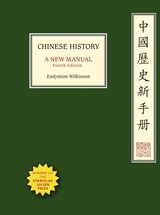 Chinese History: A New Manual, Fourth Edition
Endymion Wilkinson
Harvard University Press, 2015 Endymion Wilkinson’s bestselling manual of Chinese history has long been an indispensable guide to all those interested in the civilization and history of China. The hugely enlarged third edition won the Stanislas Julien Prize for 2014. In the fourth edition the entire work has been corrected and updated and many sections rewritten.
Fifteen years in the making, Chinese History introduces students to different types of transmitted, excavated, and artifactual sources from prehistory to the twenty-first century. It also examines the context in which the sources were produced, preserved, and received, the problems of research and interpretation associated with them, and the best, most up-to-date secondary works. Because history has always played a central role in Chinese politics and culture, special attention is devoted to the strengths and weaknesses of Chinese historiography.
Chinese History comprises fourteen book-length parts subdivided into a total of seventy-six chapters: Books 1–9 cover Language; People; Geography and the Environment; Governing and Educating; Ideas and Beliefs, Literature, and the Fine Arts; Agriculture, Food, and Drink; Technology and Science; Trade; and Historiography. Books 10–13 present primary and secondary sources chronologically by period. Book 14 is on historical bibliography. Electronic resources are covered throughout.
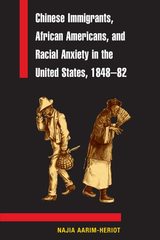 Chinese Immigrants, African Americans, and Racial Anxiety in the United States, 1848-82
Najia Aarim-Heriot
University of Illinois Press, 2003 The “Chinese question” and the “Negro problem” were bound up with one another in nineteenth-century America. Indeed, the negative stereotypes, exclusionary laws, and incendiary rhetoric employed against both populations bore striking similarities. Najia Aarim-Heriot forcefully demonstrates that the anti-Chinese sentiment behind the passage of the Chinese Exclusion Act of 1882 is inseparable from the racial double standards applied by mainstream white society toward white and nonwhite groups during the same period. Aarim-Heriot argues that previous studies on American Sinophobia have overemphasized the resentment labor organizations felt toward incoming Chinese workers. As a result, scholars have overlooked the broader ways in which the growing nation sought to define and unify itself through the exclusion and oppression of nonwhite peoples. A challenge to traditional approaches to Chinese American history, Chinese immigrants, African Americans, and Racial Anxiety in the United States, 1848–82 offers a holistic examination of American Sinophobia and the racialization of national immigration policies.
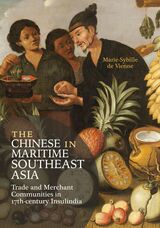 The Chinese in Maritime Southeast Asia: Trade and Merchant Communities in 17th-century Insulindia
Marie-Sybille de Vienne
National University of Singapore Press, 2025 An in-depth exploration of the Dutch East-India Company and what its history reveals about the Chinese community in the Dutch East Indies.
Connections between Asian and European markets increased dramatically in the seventeenth century, indicating a turning point in the global history of trade. The Dutch East-India Company (or VOC) was central to this process; however, counter to the VOC’s aims, the winners of the game in maritime Southeast Asia were often Chinese merchants. As this book shows, at the time, these merchants were the only economic agents capable of trading both in major Southeast Asian commercial hubs and developing exchanges with China and Japan. The Chinese operated with a flexibility of means and a fluidity of management that allowed them to react rapidly and quickly gain returns on investment. In Batavia, as in other Southeast Asian emporiums, the increasingly numerous and diverse Chinese elites assumed direct responsibility for the management of their community; this made them the most important non-European free community in the city during the second half of the seventeenth century.
The Chinese in Maritime Southeast Asia tells this remarkable story through an examination of the VOC’s abundant sources, which record relations between the Chinese minority and the Dutch rulers who relied upon them.
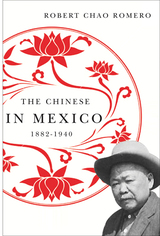 The Chinese in Mexico, 1882-1940
By Robert Chao Romero
University of Arizona Press, 2010 An estimated 60,000 Chinese entered Mexico during the late nineteenth and early twentieth centuries, constituting Mexico’s second-largest foreign ethnic community at the time. The Chinese in Mexico provides a social history of Chinese immigration to and settlement in Mexico in the context of the global Chinese diaspora of the era.
Robert Romero argues that Chinese immigrants turned to Mexico as a new land of economic opportunity after the passage of the U.S. Chinese Exclusion Act of 1882. As a consequence of this legislation, Romero claims, Chinese immigrants journeyed to Mexico in order to gain illicit entry into the United States and in search of employment opportunities within Mexico’s developing economy. Romero details the development, after 1882, of the “Chinese transnational commercial orbit,” a network encompassing China, Latin America, Canada, and the Caribbean, shaped and traveled by entrepreneurial Chinese pursuing commercial opportunities in human smuggling, labor contracting, wholesale merchandising, and small-scale trade.
Romero’s study is based on a wide array of Mexican and U.S. archival sources. It draws from such quantitative and qualitative sources as oral histories, census records, consular reports, INS interviews, and legal documents. Two sources, used for the first time in this kind of study, provide a comprehensive sociological and historical window into the lives of Chinese immigrants in Mexico during these years: the Chinese Exclusion Act case files of the U.S. Immigration and Naturalization Service and the 1930 Mexican municipal census manuscripts. From these documents, Romero crafts a vividly personal and compelling story of individual lives caught in an extensive network of early transnationalism.
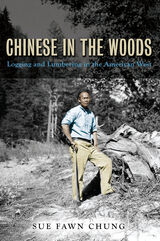 Chinese in the Woods: Logging and Lumbering in the American West
Sue Fawn Chung
University of Illinois Press, 2015 Though recognized for their work in the mining and railroad industries, the Chinese also played a critical role in the nineteenth-century lumber trade. Sue Fawn Chung continues her acclaimed examination of the impact of Chinese immigrants on the American West by bringing to life the tensions, towns, and lumber camps of the Sierra Nevada during a boom period of economic expansion. Chinese workers labored as woodcutters and flume-herders, lumberjacks and loggers. Exploding the myth of the Chinese as a docile and cheap labor army, Chung shows Chinese laborers earned wages similar to those of non-Asians. Men working as camp cooks, among other jobs, could make even more. At the same time, she draws on archives and archaeology to reconstruct everyday existence, offering evocative portraits of camp living, small town life, personal and work relationships, and the production and technical aspects of a dangerous trade. Chung also explores how Chinese used the legal system to win property and wage rights and how economic and technological change ultimately diminished Chinese participation in the lumber industry. Eye-opening and meticulous, Chinese in the Woods rewrites an important chapter in the history of labor and the American West.
Chinese Independent Cinema: Past, Present, and a Questionable Future
Chris Berry
Amsterdam University Press, 2025 Independent cinema in China is not only made outside the commercial system but also without being submitted for censorship. We know that for several decades it has been the crucible out of which China’s most exciting new films have flowed. The essays in this volume interrogate what else we think we know. Did it really start with Wu Wenguang and Bumming in Beijing in 1990, or can its roots be traced back much earlier? What are its aesthetics? And its ethics, including of gender and class? Where do audiences watch these films in China and how do they circulate? And, since the 2017 Film Law defined uncensored films as illegal, is independent Chinese cinema still alive? What does it mean today? And does it have a future? The essays in this anthology—many by exciting new scholars—explore these urgent questions.
Chinese Investment in U.S. Aviation
Chad J. R. Ohlandt
RAND Corporation, 2017 This report assesses Chinese investment in U.S. aviation from 2005 to 2016. It provides context in China’s demand for aviation products and aviation industrial policies, while assessing technology transfers and impact on U.S. competitiveness. Chinese investment in U.S. aviation over the past decade has primarily involved lower-technology general aviation manufacturers that do not affect U.S. competitiveness.
 Chinese Kinesthetic Forms
Eugene Y. Wang
Harvard University Press Chinese Kinesthetic Forms is a collection of papers, originally presented at Harvard FAS CAMLab in Fall 2022, that chart the distinctive richness of movement in China across historical contexts and cultural forms—from medieval dance and music evoking visions of Buddhist paradises, to the literati brush arts of painting and calligraphy, to theater and martial arts, to the renditions of all of the above in poetry, cinema, and digital media. Contributions explore how movement, as both expression and object of perception, unfolds experiential dimensions beyond the corporeal, encompassing ritual and spirituality, cosmology, and social relations. Representing original work by both emerging and established scholars, the volume offers a dynamic intervention into ongoing conversations on dance, kinesthetics, and China’s long history of performance. It ultimately argues for an understanding of movement not as an abstract concept, but instead as a fundamental organizing principle of human experience and expression.
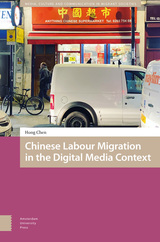 Chinese Labour Migration in the Digital Media Context
Hong Chen
Amsterdam University Press, 2025 What does it mean to a family when parents go abroad for economic gains while leaving their children behind? How do they maintain a family when living in different areas, separated for years? How do emerging digital media like instant messaging, social media, and webcam calls impact the everyday lives of today’s transnational families? Drawing on immersive ethnography conducted among UK-based Chinese labour migrants, their left-behind children and caregivers, this book explores how they employ digital media to negotiate family roles and maintain kinship ties. While virtual connections are indispensable, they are not a panacea for physical separation; rather, they introduce complexity to family dynamics. Probing the bittersweet experiences of various family members, it portrays how mediated familial communications intertwine with transnational socio-economic asymmetries and intra-familial dynamics. This book offers an interdisciplinary perspective for general publics and academics interested in migration studies, family and gender studies, and media and communications.
The Chinese Lake Murders
Robert van Gulik
University of Chicago Press, 1979 The Chinese Lake Murders describes how Judge Dee solves three difficult cases in A.D. 666, shortly after he has been appointed magistrate of Han-yuan.
"[Robert van Gulik] deftly interweaves three criminal cases involving exotic yet universally recognizable characters, then has his Judge Dee provide a surprising yet most plausible solution."—New York Times Book Review
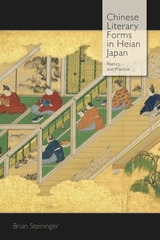 Chinese Literary Forms in Heian Japan: Poetics and Practice
Brian Steininger
Harvard University Press, 2017 Written Chinese served as a prestigious, cosmopolitan script across medieval East Asia, from as far west as the Tarim Basin to the eastern kingdom of Heian period Japan (794–1185). In this book, Brian Steininger revisits the mid-Heian court of the Tale of Genji and the Pillow Book, where literary Chinese was not only the basis of official administration, but also a medium for political protest, sermons of mourning, and poems of celebration.
Chinese Literary Forms in Heian Japan reconstructs the lived practice of Chinese poetic and prose genres among Heian officials, analyzing the material exchanges by which documents were commissioned, the local reinterpretations of Tang aesthetic principles, and the ritual venues in which literary Chinese texts were performed in Japanese vocalization. Even as state ideology and educational institutions proclaimed the Chinese script’s embodiment of timeless cosmological patterns, everyday practice in this far-flung periphery subjected classical models to a string of improvised exceptions. Through careful comparison of literary and documentary sources, this book provides a vivid case study of one society’s negotiation of literature’s position—both within a hierarchy of authority and between the incommensurable realms of script and speech.
The Chinese Love Pavilion: A Novel
Paul Scott
University of Chicago Press, 2013 Paul Scott is most famous for his much-beloved tetralogy The Raj Quartet, an epic that chronicles the end of the British rule in India with a cast of vividly and memorably drawn characters. Inspired by Scott’s own time spent in India and Malaya during World War II, this two powerful novel provides valuable insight into how foreign lands changed the British who worked and fought in them, hated and loved them.
The Chinese Love Pavilion follows a young British clerk, Tom Brent, who must track down a former friend—now suspected of murder—in Malaya. Tom faces great danger, both from the mysterious Malayan jungles and the political tensions between British officers, but the novel is perhaps most memorable for the strange, beautiful romance between Tom and a protean Eurasian beauty whom he meets in the eponymous Chinese Love Pavilion.
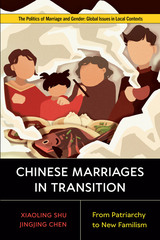 Chinese Marriages in Transition: From Patriarchy to New Familism
Xiaoling Shu
Rutgers University Press, 2023 Outdated models of Chinese gender roles, marriage, and family transitions portray these changes as streamlined and unidirectional, from traditional to modern, public to private, collective to individual. Chinese Marriages in Transition documents the complex, nuanced, and multidirectional nature of these cultural transformations. Using complex and large-scale historical national data as well as comprehensive data from multiple countries, Xiaoling Shu and Jingjing Chen demonstrate that, while the second demographic transition is unfolding in many advanced Western societies, it is not necessarily a normative form of societal transition. Working instead from a framework of "new familism," Shu and Chen show that Chinese new familism consists of both old and new values, including the persistence of some traditional beliefs and practices, accompanied by a transition to modern perceptions of gender, and adaption to some modern forms of family formation. This book is freely available in an open access edition thanks to TOME (Toward an Open Monograph Ecosystem)— a collaboration of the Association of American Universities, the Association of University Presses, and the Association of Research Libraries—and the generous support of the University of California, Davis. Learn more at the TOME website, available at: openmonographs.org.
Download the open access book here.
The Chinese Maze Murders: A Judge Dee Mystery
Robert van Gulik
University of Chicago Press, 1997 The very first mystery in the beloved series starring Judge Dee, a detective whom the Los Angeles Times ranked with Sherlock Holmes!
Join the T'ang Dynasty detective Judge Dee on his very first full-length mystery! Poisoned plums, a cryptic scroll picture, passionate love letters, and a hidden murderer with a penchant for torturing and killing women lead Judge Dee to the heart of the Governor’s garden maze and the answers to three interwoven mysteries. This book kicked off Robert van Gulik's long-running series and introduced countless readers to a cozy, clever series and the incredible detective at its center. Read this one and you'll quickly find yourself seeking out the whole series.
Chinese Medicinal Plants, Herbal Drugs and Substitutes: An Identification Guide
Christine Leon and Lin Yu-Lin
Royal Botanic Gardens, Kew, 2017 The product of fifteen years of collecting activity throughout China, this book offers the first comprehensive, botanically authoritative, and practical illustrated identification guide to Chinese medicinal plants and drugs and their substitutes. The herbal drugs included in the book are officially recognized in the Chinese pharmacopoeia, with an eye toward drugs that are common in international trade, as well as those recognized by Western medical associations. The book is laid out to allow quick and easy cross-referencing of official and substitute species and will be ideal for those without botanical information training. A joint project of the Royal Botanic Gardens, Kew, and the Institute of Medicinal Plant Development at the Chinese Academy of Medical Sciences, it will be indispensable for anyone working with traditional or herbal remedies.
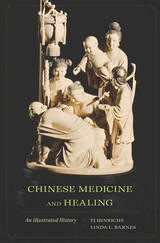 Chinese Medicine and Healing: An Illustrated History
TJ Hinrichs
Harvard University Press, 2013 Chinese Medicine and Healing is a comprehensive introduction to a rich array of Chinese healing practices as they have developed through time and across cultures. Contributions from fifty-eight leading international scholars in such fields as Chinese archaeology, history, anthropology, religion, and medicine make this a collaborative work of uncommon intellectual synergy, and a vital new resource for anyone working in East Asian or world history, in medical history and anthropology, and in biomedicine and complementary healing arts.
This illustrated history explores the emergence and development of a wide range of health interventions, including propitiation of disease-inflicting spirits, divination, vitality-cultivating meditative disciplines, herbal remedies, pulse diagnosis, and acupuncture. The authors investigate processes that contribute to historical change, such as competition between different types of practitioner—shamans, Daoist priests, Buddhist monks, scholar physicians, and even government officials. Accompanying vignettes and illustrations bring to life such diverse arenas of health care as childbirth in the Tang period, Yuan state-established medical schools, fertility control in the Qing, and the search for sexual potency in the People’s Republic.
The two final chapters illustrate Chinese healing modalities across the globe and address the challenges they have posed as alternatives to biomedical standards of training and licensure. The discussion includes such far-reaching examples as Chinese treatments for diphtheria in colonial Australia and malaria in Africa, the invention of ear acupuncture by the French and its worldwide dissemination, and the varying applications of acupuncture from Germany to Argentina and Iraq.
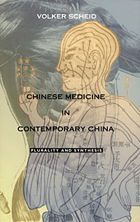 Chinese Medicine in Contemporary China: Plurality and Synthesis
Volker Scheid
Duke University Press, 2002 As a traditional healing art that has established a contemporary global presence, Chinese medicine defies categories and raises many interesting questions. If Chinese medicine is "traditional," why has it not disappeared with the rest of traditional Chinese society? If, as some claim, it is a science, what does that imply about what we call science? What is the secret of Chinese medicine's remarkable adaptability that has allowed it to prosper for more than 2,000 years? In Chinese Medicine in Contemporary China Volker Scheid presents an ethnography of Chinese medicine that seeks to answer these questions, but his ethnography is informed by some atypical approaches.
Scheid, a medical anthropologist and practitioner of Chinese medicine in practice since 1983, has produced an ethnography that accepts plurality as an intrinsic and nonreducible aspect of medical practice. It has been widely noted that a patient visiting ten different practitioners of Chinese medicine may receive ten different prescriptions for the same complaint, yet many of these various treatments may be effective. In attempting to illuminate the plurality in Chinese medical practice, Scheid redefines-and in some cases abandons-traditional anthropological concepts such as tradition, culture, and practice in favor of approaches from disciplines such as science and technology studies, social psychology, and Chinese philosophy. As a result, his book sheds light not only on Chinese medicine but also on the Western academic traditions used to examine it and presents us with new perspectives from which to deliberate the future of Chinese medicine in a global context.
Chinese Medicine in Contemporary China is the product of two decades of research including numerous interviews and case studies. It will appeal to a western academic audience as well as practitioners of Chinese medicine and other interested medical professionals, including those from western biomedicine.
 Chinese Medicine Men: Consumer Culture in China and Southeast Asia
Sherman Cochran
Harvard University Press, 2006 In this book, Sherman Cochran reconsiders the nature and role of consumer culture in the spread of cultural globalization. He moves beyond traditional debates over Western influence on non-Western cultures to examine the points where Chinese entrepreneurs and Chinese-owned businesses interacted with consumers. Focusing on the marketing of medicine, he shows how Chinese constructed consumer culture in China and Southeast Asia and extended it to local, national, and transnational levels. Through the use of advertisements, photographs, and maps, he illustrates the visual forms that Chinese enterprises adopted and the far-flung markets they reached.
Cochran brings to light enduring features of the Chinese experience with consumer culture. Surveying the period between the 1880s and the 1950s, he observes that Chinese businesses surpassed their Western counterparts in capturing Chinese and Southeast Asian sales of medicine in both peacetime and wartime. He provides revealing examples of Chinese entrepreneurs’ dealings with Chinese and Japanese political and military leaders, particularly during the Sino–Japanese War of 1937–45. The history of Chinese medicine men in pre-socialist China, he suggests, has relevance for the twenty-first century because they achieved goals—constructing a consumer culture, competing with Western-based corporations, forming business-government alliances, capturing national and transnational markets—that their successors in contemporary China are currently seeking to attain.
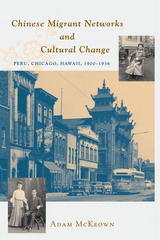 Chinese Migrant Networks and Cultural Change: Peru, Chicago, and Hawaii 1900-1936
Adam McKeown
University of Chicago Press, 2001 Inspired by recent work on diaspora and cultural globalization, Adam McKeown asks in this new book: How were the experiences of different migrant communities and hometowns in China linked together through common networks? Chinese Migrant Networks and Cultural Change argues that the political and economic activities of Chinese migrants can best be understood by taking into account their links to each other and China through a transnational perspective. Despite their very different histories, Chinese migrant families, businesses, and villages were connected through elaborate networks and shared institutions that stretched across oceans and entire continents. Through small towns in Qing and Republican China, thriving enclaves of businesses in South Chicago, broad-based associations of merchants and traders in Peru, and an auspicious legacy of ancestors in Hawaii, migrant Chinese formed an extensive system that made cultural and commercial exchange possible.
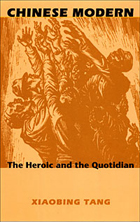 Chinese Modern: The Heroic and the Quotidian
Xiaobing Tang
Duke University Press, 2000 Chinese Modern examines crucial episodes in the creation of Chinese modernity during the turbulent twentieth century. Analyzing a rich array of literary, visual, theatrical, and cinematic texts, Xiaobing Tang portrays the cultural transformation of China from the early 1900s through the founding of the People’s Republic, the installation of the socialist realist aesthetic, the collapse of the idea of utopia in the aftermath of the Cultural Revolution, and the gradual cannibalization of the socialist past by consumer culture at the century’s end. Throughout, he highlights the dynamic tension between everyday life and the heroic ideal. Tang uncovers crucial clues to modern Chinese literary and cultural practices through readings of Wu Jianren’s 1906 novel The Sea of Regret and works by canonical writers Lu Xun, Ding Ling, and Ba Jin. For the midcentury, he broadens his investigation by considering theatrical, cinematic, and visual materials in addition to literary texts. His reading of the 1963 play The Young Generation reveals the anxiety and terror underlying the exhilarating new socialist life portrayed on the stage. This play, enormously influential when it first appeared, illustrates the utopian vision of China’s lyrical age and its underlying discontents—both of which are critical for understanding late-twentieth-century China. Tang closes with an examination of post–Cultural Revolution nostalgia for the passion of the lyrical age. Throughout Chinese Modern Tang suggests a historical and imaginative affinity between apparently separate literatures and cultures. He thus illuminates not only Chinese modernity but also the condition of modernity as a whole, particularly in light of the postmodern recognition that the market and commodity culture are both angel and devil. This elegantly written volume will be invaluable to students of China, Asian studies, literary criticism, and cultural studies, as well as to readers who study modernity.
 Chinese Modernism in the Era of Reforms: Cultural Fever, Avant-Garde Fiction, and the New Chinese Cinema
Xudong Zhang
Duke University Press, 1997 Blending history and theory, Chinese Modernism in the Era of Reforms offers both a historical narrative and a critical analysis of the cultural visions and experiences of China’s post-Mao era. In this volume, Xudong Zhang rethinks Chinese modernism as a historical genre that arose in response to the historical experience of Chinese modernity rather than as an autonomous aesthetic movement. He identifies the ideologies of literary and cultural styles in the New Era (1979–1989) through a critical reading of the various “new waves” of Chinese literature, film, and intellectual discourse.
In examining the aesthetic and philosophical formulations of the New Era’s intellectual elites, Zhang first analyzes the intense cultural and intellectual debates, known as the “Great Cultural Discussion” or “Cultural Fever” that took place in Chinese urban centers in the mid- and late 1980s. Chinese literary modernism is then explored, specifically in relation to Deng Xiaoping’s sweeping reforms and with a focus on the changing literary sensibility and avant-garde writers such as Yu Hua, Ge Fei, and Su Tong. Lastly, Zhang looks at the the making of New Chinese Cinema and films such as Yellow Earth, Horse Thief, and King of the Children—films through which Fifth Generation filmmakers first developed a style independent from socialist realism. By tracing the origins and contemporary elaboration of the idea of Chinese modernism, Zhang identifies the discourse of modernism as one of the decisive formal articulations of the social dynamism and cultural possibilities of post-Mao China.
Capturing the historical experience and the cultural vision of China during a crucial decade in its emergence as a world power, Chinese Modernism in the Era of Reforms will interest students and scholars of modernism, Chinese literature and history, film studies, and cultural studies.
 The Chinese Must Go: Violence, Exclusion, and the Making of the Alien in America
Beth Lew-Williams
Harvard University Press, 2018 Winner of the Ray Allen Billington Prize
Winner of the Ellis W. Hawley Prize
Winner of the Sally and Ken Owens Award
Winner of the Vincent P. DeSantis Book Prize
Winner of the Caroline Bancroft History Prize
“A powerful argument about racial violence that could not be more timely.”
—Richard White
“A riveting, beautifully written account…that foregrounds Chinese voices and experiences. A timely and important contribution to our understanding of immigration and the border.”
—Karl Jacoby, author of Shadows at Dawn
In 1885, following the massacre of Chinese miners in Wyoming Territory, communities throughout California and the Pacific Northwest harassed, assaulted, and expelled thousands of Chinese immigrants. The Chinese Must Go shows how American immigration policies incited this violence, and how this gave rise to the concept of the “alien” in America.
Our story begins in the 1850s, before federal border control established strict divisions between citizens and aliens—and long before Congress passed the Chinese Restriction Act, the nation’s first attempt to bar immigration based on race and class. When this unprecedented experiment failed to slow Chinese migration, armed vigilante groups took the matter into their own hands. Fearing the spread of mob violence, policymakers redoubled their efforts to seal the borders, overhauling immigration law and transforming America’s relationship with China in the process. By tracing the idea of the alien back to this violent era, Lew-Williams offers a troubling new origin story of today’s racialized border.
“The Chinese Must Go shows how a country that was moving, in a piecemeal and halting fashion, toward an expansion of citizenship for formerly enslaved people and Native Americans, came to deny other classes of people the right to naturalize altogether…The stories of racist violence and community shunning are brutal to read.”
—Rebecca Onion, Slate
 The Chinese Nail Murders
Robert van Gulik
University of Chicago Press, 1977 Judge Dee and his four helpers solve the murders of an honored merchant, a kindly boxing master, and a paper merchant's wife, whose corpse has no head. They succeed in spite of strong pressure on Judge Dee from higher-ups to bring his investigation, which has temporarily generated unrest among the populace, rapidly to an end or face dismissal and serious punishment. The case of the headless corpse is based on a thirteenth-century Chinese casebook; the nail murder, one of the most famous motifs in Chinese crime literature, is first described in the same text.
"So scrupulously in the classic Chinese manner yet so nicely equipped with everything to satisfy the modern reader."—New York Times
Robert Van Gulik (1910-67) was a Dutch diplomat and an authority on Chinese history and culture. He drew his plots from the whole body of Chinese literature, especially from the popular detective novels that first appeared in the seventeenth century.
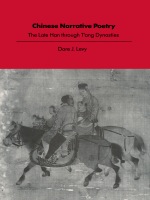 Chinese Narrative Poetry: The Late Han Through T'ang Dynasties
Dore J. Levy
Duke University Press, 1988 Chinese Narrative Poetry brings a new perspective to some of China's best-loved and most influential poems, including Ts'ai Yen's "Poem of Affliction," Po Chu-yi's "Song of Everlasting Sorrow," and Wei Chuang's recently discovered "Song of the Lady of Ch'in." Composed in the shih form during the Late Han, Six Dynasties, and T'ang periods, these poems stand out as masterworks of narrative art. Yet paradoxically, their narrative qualities have been little recognized or explored in either traditional Chinese or modern Western scholarship. The reason for this neglect is that Western literary traditions acknowledge their origins in epic poetry and thus take narrative for granted, but the Chinese tradition is fundametally based on lyric and does not admit of a separate category for narrative poetry. Drawing on both classical Chinese critical works and the most recent Western contributions to the theory of narrative, Levy shows how narrative elements developed out of the lyrical conventions of shih. In doing so, she accomplishes a double purpose, guiding the modern reader to an understanding of the nature of narrative in Chinese poetry and shedding light on the ways in which Chinese poets adapted the devises of lyric to the needs of a completely different expressive mode. Students of Chinese literature will welcome this pathbreaking study, but Chinese Narrative Poetry will interest other scholars as well because it addresses questions of crucial importance for literary theory and comparative literature, particularly the central issue of the applicability of Western critical concepts to non-Western literature and culture.
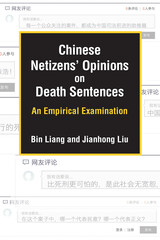 Chinese Netizens' Opinions on Death Sentences: An Empirical Examination
Bin Liang and Jianhong Liu
University of Michigan Press, 2021 Few social issues have received more public attention and scholarly debate than the death penalty. While the abolitionist movement has made a successful stride in recent decades, a small number of countries remain committed to the death penalty and impose it with a relatively high frequency. In this regard, the People’s Republic of China no doubt leads the world in both numbers of death sentences and executions. Despite being the largest user of the death penalty, China has never conducted a national poll on citizens’ opinions toward capital punishment, while claiming “overwhelming public support” as a major justification for its retention and use. Chinese Netizens’ Opinions on Death Sentences: An Empirical Examination uses a forum of public comments to explore and examine Chinese netizens’ opinions on the death penalty. Based on a content analysis of 38,512 comments collected from 63 cases in 2015, this study examines the diversity and rationales of netizens’ opinions, netizens’ interactions, and their evaluation of China’s criminal justice system. In addition, the book discusses China’s social, systemic, and structural problems and critically examines the rationality of netizens’ opinions based on Habermas’s communicative rationality framework. Readers will be able to contextualize Chinese netizens’ discussions and draw conclusions about commonalities and uniqueness of China’s death penalty practice.
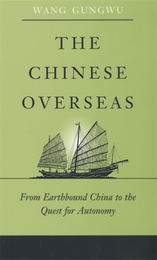 The Chinese Overseas: From Earthbound China to the Quest for Autonomy
Wang Gungwu
Harvard University Press, 2000 The Chinese overseas now number 25 to 30 million, yet the 2,000-year history of Chinese attempts to venture abroad and the underlying values affecting that migration have never before been presented in a broad overview. Despite centuries of prohibition against leaving the land and traveling and settling overseas, the "earthbound" Chinese--first traders, then peasants and workers--eventually found new sources of livelihood abroad. The practice of sojourning, being always temporarily away from home, was the answer the Chinese overseas found to deal with imperial and orthodox concerns. Today their challenge is to find an alternative to either returning or assimilating by seeking a new kind of autonomy in a world that will come to acknowledge the ideal of multicultural states.
In pursuing this story, international scholar Wang Gungwu uncovers some major themes of global history: the coming together of Asian and European civilizations, the ambiguities of ethnicity and diasporic consciousness, and the tension between maintaining one's culture and assimilation.
Chinese Paintings in Chinese Publications, 1956–1968: An Annotated Bibliography and Index to the Paintings
Ellen Johnston Laing
University of Michigan Press, 1969 This bibliography includes publications issued between 1956 and August 1968 that reproduce Chinese paintings now in Chinese public or private collections. The great majority of these publications were produced in Mainland China, Taiwan, Hong Kong, or Japan. Each publication included in the bibliography has been provided with a detailed physical description of the publication itself: the amounts of text , the number of plates in color and in monochrome, and a general evaluation of the quality of the reproductions. The title by which each work is referred to in the index is included at the end of each entry.
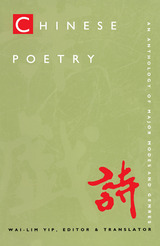 Chinese Poetry, 2nd ed., Revised: An Anthology of Major Modes and Genres
Wai-lim Yip, editor and translator
Duke University Press, 1997 This is the first paperback edition of a classic anthology of Chinese poetry. Spanning two thousand years—from the Book of Songs (circa 600 B.C.) to the chü form of the Yuan Dynasty (1260–1368)—these 150 poems cover all major genres that students of Chinese poetry must learn.
Newly designed, the unique format of this volume will enhance its reputation as the definitive introduction to Chinese poetry, while its introductory essay on issues of Chinese aesthetics will continue to be an essential text on the problems of translating such works into English. Each poem is printed with the original Chinese characters in calligraphic form, coordinated with word-for-word annotations, and followed by an English translation. Correcting more than a century of distortion of the classical Chinese by translators unconcerned with the intricacies and aesthetics of the Chinese language, these masterful translations by Wai-lim Yip, a noted and honored translator and scholar, allow English readers to enter more easily into the dynamic of the original poems. Each section of the volume is introduced by a short essay on the mode or genre of poem about to be presented and is followed by a comprehensive bibliography.
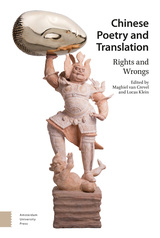 Chinese Poetry and Translation: Rights and Wrongs
Maghiel van Crevel
Amsterdam University Press, 2020 Chinese Poetry and Translation: Rights and Wrongs offers fifteen essays on the triptych of poetry + translation + Chinese. The collection has three parts: "The Translator's Take," "Theoretics," and "Impact." The conversation stretches from queer-feminist engagement with China's newest poetry to philosophical and philological reflections on its oldest, and from Tang- and Song-dynasty classical poetry in Western languages to Baudelaire and Celan in Chinese. Translation is taken as an interlingual and intercultural act, and the essays foreground theoretical expositions and the practice of translation in equal but not opposite measure. Poetry has a transforming yet ever-acute relevance in Chinese culture, and this makes it a good entry point for studying Chinese-foreign encounters. Pushing past oppositions that still too often restrict discussions of translation-form versus content, elegance versus accuracy, and "the original" versus "the translated" - this volume brings a wealth of new thinking to the interrelationships between poetry, translation, and China.
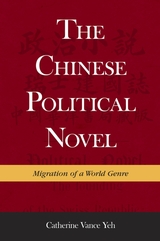 The Chinese Political Novel: Migration of a World Genre
Catherine Vance Yeh
Harvard University Press, 2015 The political novel, which enjoyed a steep yet short rise to international renown between the 1830s and the 1910s, is primarily concerned with the nation’s political future. It offers a characterization of the present, a blueprint of the future, and the image of the heroes needed to get there. With the standing it gained during its meteoric rise, the political novel helped elevate the novel altogether to become the leading literary genre of the twentieth century worldwide.
Focusing on its adaptation in the Chinese context, Catherine Vance Yeh traces the genre from Disraeli’s England through Europe and the United States to East Asia. Her study goes beyond comparative approaches and nation-state- and language-centered histories of literature to examine the intrinsic connections among literary works. Through detailed studies, especially of the Chinese exemplars, Yeh explores the tensions characteristic of transcultural processes: the dynamics through which a particular, and seemingly local, literary genre goes global; the ways in which such a globalized literary genre maintains its core features while assuming local identity and interacting with local audiences and political authorities; and the relationship between the politics of form and the role of politics in literary innovation.
Chinese Popular Culture and the State, Volume 9
Jing Wang, ed.
Duke University Press The State Question in Chinese Popular Culture presents a series of groundbreaking essays that challenge the paradigm dividing Chinese culture into "official" and "unofficial" categories. This binary, which mirrors the "high/low" dichotomy familiar to all practitioners of cultural studies, finds its roots in Cold-War Western romanticization of a Chinese popular culture that stood in defiant opposition to the Communist state. This special issue disputes such simplistic representations and offers new critical trajectories crucial to the study of contemporary Chinese popular culture. Contributors. Tani E. Barlow, Dai Jinhua, Judith Farquhar, David S. G. Goodman, James L. Hevia, Li Hsiaoti, Ralph Litzinger, Eric Kit-Wa Ma, Jonathan Scott Noble, Jing Wang
Chinese Popular Religion in Text and Acts
Shin-yi Chao
Amsterdam University Press, 2024 This volume explores practices and experiences in Chinese popular religion. The research adds new materials and new approaches to well-known worships such as the cults of doomsday, underworld, and Lord Guan on the one hand, and draws attention to under-the-radar deities and holy figures hiding in the mountainous countryside or among the urban crowd. While this book centers on Chinese popular religion, it will be of use to non-China scholars in folklore, religious art, and ritual studies as well as China scholars in popular culture from late-medieval to contemporary times.
 The Chinese Postmodern: Trauma and Irony in Chinese Avant-Garde Fiction
Xiaobin Yang
University of Michigan Press, 2002 The Chinese Postmodern is a pioneering study of today's Chinese experimental fiction, exploring the works of such major writers as Can Xue, Ge Fei, Ma Yuan, Mo Yan, Xu Xiaohe, and Yu Hua from the perspective of cultural and literary postmodernity. Focusing on the interplay between historical psychology and representational mode, and between political discourse and literary rhetoric, it examines the problem of Chinese postmodernity against the background of the cultural-political reality of twentieth-century China.
The book seeks to redefine Chinese modernity and postmodernity through the analyses of both orthodox and avant-garde works. In doing so, the author draws on a number of theories, psychoanalysis and deconstruction in particular, revealing the hidden connection between the deconstructive mode of writing and the experience of history after trauma and showing how avant-garde literature brings about a varied literary paradigm that defies the dominant, subject-centered one in twentieth-century China.
The distinctiveness of The Chinese Postmodern is also found in its portrayal of the changes of literary paradigms in modern Chinese literature. By way of characterizing avant-garde fiction, it provides an overview of twentieth-century Chinese literature and offers a theorization of the intellectual history of modern China. Other issues concerning literary theory are explored, including the relationships between postmodernity and totalitarian discourse, between historical trauma and literary writing, and between psychic trauma and rhetorical irony. This book will appeal to readers in the fields of Chinese literature and culture, modern Chinese history, literary theory, and comparative literature.
Xiaobin Yang is Croft Assistant Professor, University of Mississippi.
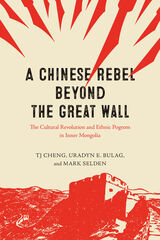 A Chinese Rebel beyond the Great Wall: The Cultural Revolution and Ethnic Pogrom in Inner Mongolia
TJ Cheng, Uradyn E. Bulag, and Mark Selden
University of Chicago Press, 2023 A striking first-person account of the Cultural Revolution in Inner Mongolia, embedded in a close examination of the historical evidence on China’s minority nationality policies to the present.
During the Great Leap Forward, as hundreds of thousands of Chinese famine refugees headed to Inner Mongolia, Cheng Tiejun arrived in 1959 as a middle school student. In 1966, when the PRC plunged into the Cultural Revolution, he joined the Red Guards just as Inner Mongolia’s longtime leader, Ulanhu, was purged. With the military in control, and with deepening conflict with the Soviet Union and its ally Mongolia on the border, Mongols were accused of being nationalists and traitors. A pogrom followed, taking more than 16,000 Mongol lives, the heaviest toll anywhere in China.
At the heart of this book are Cheng’s first-person recollections of his experiences as a rebel. These are complemented by a close examination of the documentary record of the era from the three coauthors. The final chapter offers a theoretical framework for Inner Mongolia’s repression. The repression’s goal, the authors show, was not to destroy the Mongols as a people or as a culture—it was not a genocide. It was, however, a “politicide,” an attempt to break the will of a nationality to exercise leadership of their autonomous region. This unusual narrative provides urgently needed primary source material to understand the events of the Cultural Revolution, while also offering a novel explanation of contemporary Chinese minority politics involving the Uyghurs, Tibetans, and Mongols.
 The Chinese Red Army, 1927-1963: An Annotated Bibliography
Edward Rhoads
Harvard University Press Imperialism, pernicious as it was in most respects, served as the prime catalyst for social change in China throughout the turbulent period from 1895 to 1913. Starting with this premise, Edward Rhoads traces the social, political, and economic history of the republican revolution. In his view, after the Boxer uprising, the Manchu court, usually called supine and reactionary, instituted a program of reform that was a serious, comprehensive, and often successful attempt at radical social transformation. It failed, but it politicized the Chinese people to an unprecedented degree--and it marks the entrance of China into the modern era.
The post-Boxer reforms attracted many revolutionaries and defused a serious revolutionary threat. Contrary to traditional accounts, Sun Yat-sen and his Revolutionary Alliance did not move easily from success to success. On the eve of the 1911 revolution, in fact, the movement was disorganized and demoralized. Its ultimate victory came less from its own efforts than from the failure of the incumbent rulers to win the support of the nonrevolutionary elite.
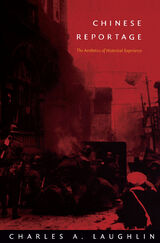 Chinese Reportage: The Aesthetics of Historical Experience
Charles A. Laughlin
Duke University Press, 2002 Chinese Reportage details for the first time in English the creation and evolution of a distinctive literary genre in twentieth-century China. Reportage literature, while sharing traditional journalism’s commitment to the accurate, nonfictional portrayal of experience, was largely produced by authors outside the official news media. In identifying the literary merit of this genre and establishing its significance in China’s leftist cultural legacy, Charles A. Laughlin reveals important biases that impede Western understanding of China and, at the same time, supplies an essential chapter in Chinese cultural history. Laughlin traces the roots of reportage (or baogao wenxue) to the travel literature of the Qing Dynasty but shows that its flourishing was part of the growth of Chinese communism in the twentieth century. In a modern Asian context critical of capitalism and imperialism, reportage offered the promise of radicalizing writers through a new method of literary practice and the hope that this kind of writing could in turn contribute to social revolution and China’s national self-realization. Chinese Reportage explores the wide range of social engagement depicted in this literature: witnessing historic events unfolding on city streets; experiencing brutal working conditions in 1930s Shanghai factories; struggling in the battlefields and trenches of the war of resistance against Japan, the civil war, and the Korean war; and participating in revolutionary rural, social, and economic transformation. Laughlin’s close readings emphasize the literary construction of social space over that of character and narrative structure, a method that brings out the critique of individualism and humanism underlying the genre’s aesthetics. Chinese Reportage recaptures a critical aspect of leftist culture in China with far-reaching implications for historians and sociologists as well as literary scholars.
The Chinese Revolution: A Phase in the Regeneration of a World Power
Arthur N. Holcombe
Harvard University Press Based upon several months of observation in China, Japan, and neighboring regions, and in Soviet Russia, this book, according to Lewis Gannett, in the New York Herald-Tribune “has new things to say. . . . None of the recent flood of books on China casts such revealing sidelights upon the immense revolution in process in that continent-country.” Although Professor Holcombe cannot always reveal the sources upon which his information and opinions are based, he has presented a reliable, up-to-date, impartial view of one of the greatest political movements of our generation, a book of unquestioned value to all readers interested either in the Far East or in the problems of modern world politics.
 The Chinese Short Story: Studies in Dating, Authorship, and Composition
Patrick Hanan
Harvard University Press, 1973 During the centuries of its popularity, early Chinese vernacular fiction was never adequately preserved or even documented. The great popular appeal of the short stories saved them from oblivion, but it was only in the sixteenth and seventeenth centuries that they were first collected and published.
Mr. Hanan's erudite study is the first thorough attempt to uncover the history of the Chinese short story. Using a variety of techniques, but principally that of stylistic analysis, the author solves the fundamental problem of dating the stories in terms of periods. He is able to place each story in one of three broad categories, early (ca. 1250-1450), middle (ca. 1400-1575), and late (ca. 1550-1627), and to assign some of them to,the earlier or later part of the time span. In many,cases he offers evidence of sources and influences, place of origin, and possible or probable authorship.
On the basis of the author's research, it is possible to see in minutely researched detail how the short story developed in China, what kind of men composed it, its relationship to other kinds of literature, and the main social preoccupations with which it deals.
The results of Mr. Hanan's study are vitally important to all scholars of Chinese literature. Historians and linguists will also find it valuable as a model of the innovative use of stylistic analysis.
 Chinese Silk: A Cultural History
Shelagh Vainker
Rutgers University Press, 2004 Silk is one of China’s major contributions to world civilization, the secrets of its cultivation closely guarded for generations. The famous network of trade routes between West and East is still known as the Silk Road. The organization and techniques of Chinese silk production, the uses of the silk produced––both bolts and made-up pieces––and the types and styles of its ornament are celebrated in this richly illustrated and accessible book, the first general survey to be published in English. Shelagh Vainker traces the cultural history of silk in China from its Neolithic origins to the twentieth century and considers its relationship to the other decorative arts. She traces the role of silk in Chinese history, trade, religion, and literature. Drawing on the most recent archaeological evidence from other, less perishable media such as jades and bronzes as well as paintings, poems, and other texts, Chinese Silk brings together material available until now only in Chinese, supplemented with recent acquisitions by public and private collections in the United States and Europe. The result is a book that illuminates the luxury of silk throughout the ages.
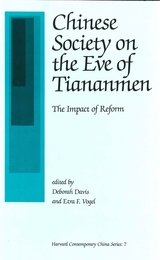 Chinese Society on the Eve of Tiananmen: The Impact of Reform
Deborah Davis
Harvard University Press By the late 1970s, state communism was everywhere in retreat. First in Eastern Europe, then in China and the Soviet Union, party leaders were compelled to devise fundamental departures from the economic procedures and structures they had confidently installed at the outset of their revolutionary victories. Perhaps no country departed more rapidly from communist economic structures than China.
Within five years of Mao Zedong’s death, reformers led by Deng Xiaoping had dismantled the people’s communes and created a range of markets that established the institutional foundations for a new form of socialism. But, unlike the Soviets and Eastern Europeans, the Chinese reformers refused to consider parallel changes in political institutions. The demonstrations in Beijing in 1989 made it clear that post-Mao economic policies had created unavoidable political consequences for the society and its leaders. In individual case studies, the twelve contributors to this volume document the uneven decollectivization and decentralization of China’s economy in the post-Mao years and the great diversity of the social and political consequences. They deal with the effects of the more materialistic and individualistic reward system on both public and private life in the countryside and in urban settings and the new expectations that economic changes engendered.
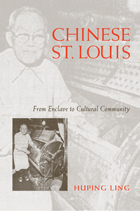 Chinese St Louis: From Enclave To Cultural Community
Huping Ling
Temple University Press, 2004 Chinese St. Louis offers the first empirical study of a Midwestern Chinese American community from its nineteenth-century origins to the present. As in many cities, Chinese newcomers were soon segregated in an enclave; in St. Louis the enclave was called "Hop Alley." Huping Ling shows how, over time, the community grew and dispersed until it was no longer marked by physical boundaries. She argues that the St. Louis experience departs from the standard models of Chinese settlement in urban areas, which are based on studies of coastal cities. Developing the concept of a cultural community, Ling shows how Chinese Americans in St. Louis have formed and maintained cultural institutions and organizations for social and political purposes throughout the city, which serve as the community's infrastructure. Thus the history of Chinese Americans in St. Louis more closely parallels that of other urban ethnic groups and offers new insight into the range of adaptation and assimilation experience in the United States.
Chinese State Enterprises: A Regional Property Rights Analysis
David Granick
University of Chicago Press, 1990 "We are indebted to David Granick for his thoughtful, careful, empirically documented study of the Chinese state industrial enterprise that not only provides a rarely attained comparative analysis but also possesses an explanatory power in suggesting how this system might evolve in the future."—Jeanne L. Wilson, Business Horizons
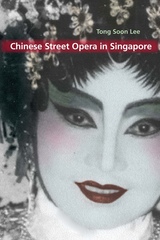 Chinese Street Opera in Singapore
Tong Soon Lee
University of Illinois Press, 2009 Since Singapore declared independence from Malaysia in 1965, Chinese street opera has played a significant role in defining Singaporean identity. Carefully tracing the history of amateur and professional performances in Singapore, Tong Soon Lee reflects on the role of street performance in fostering cultural nationalism and entrepreneurship. He explains that the government welcomes Chinese street opera performances because they combine tradition and modernism and promote a national culture that brings together Singapore's four main ethnic groups--Eurasian, Malay, Chinese, and South Asian. Chinese Street Opera in Singapore documents the ways in which this politically motivated art form continues to be influenced and transformed by Singaporean politics, ideology, and context in the twenty-first century. By performing Chinese street opera, amateur troupes preserve their rich heritage, underscoring the Confucian mind-set that a learned person engages in the arts for moral and unselfish purposes. Educated performers also control behavior, emotions, and values. They are creative and innovative, and their use of new technologies indicates a modern, entrepreneurial spirit. Their performances bring together diverse ethnic groups to watch and perform, Lee argues, while also encouraging a national attitude focused on both remembering the past and preparing for the future in Singapore.
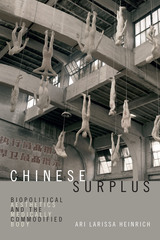 Chinese Surplus: Biopolitical Aesthetics and the Medically Commodified Body
Ari Larissa Heinrich
Duke University Press, 2018 What happens when the body becomes art in the age of biotechnological reproduction? In Chinese Surplus Ari Larissa Heinrich examines transnational Chinese aesthetic production to demonstrate how representations of the medically commodified body can illuminate the effects of biopolitical violence and postcolonialism in contemporary life. From the earliest appearance of Frankenstein in China to the more recent phenomenon of "cadaver art," he shows how vivid images of a blood transfusion as performance art or a plastinated corpse without its skin—however upsetting to witness—constitute the new "realism" of our times. Adapting Foucauldian biopolitics to better account for race, Heinrich provides a means to theorize the relationship between the development of new medical technologies and the representation of the human body as a site of annexation, extraction, art, and meaning-making.
 Chinese Theories of Literary Creation: A Historical and Critical Introduction
Zong-qi Cai, issue editor
Duke University Press, 2024 This supplement to volume 20 of Prism is the first installment of a four-part project, with roughly concurrent publication in Chinese and English. The works in this project, which include Chinese monographs by Prism’s editor Zong-qi Cai, cover Chinese theories of literature, literary creation, interpretation, and aesthetic judgment. This supplement, specifically, covers topics that include the inadequate presence of China’s literary theory and literary creation in English-language scholarship; an analytical and analytical-reconstructive approach to Six Dynasties comprehensive theories that pieces together isolated comments made by multiple authors over different times into a “theoretic collage” the philosophical foundations laid by pre-Qin and Han-Wei thinkers for the subsequent rise of literary creation the burgeoning impact of Buddhist thought on the theory of artistic creation; and a reflection on and comparison of the distinctive features of major Chinese theories of literary creation to their Western counterparts.
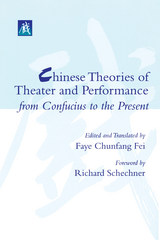 Chinese Theories of Theater and Performance from Confucius to the Present
Edited and Translated by Faye Chunfang Fei
University of Michigan Press, 2002 Through the writings of noted Chinese philosophers, scholars, artists, and critics from the time of Confucius to the present, this rich compendium provides a fascinating guided tour of China's evolving conceptions of theater and performance. The book's more than sixty selections are arranged chronologically to provide a historical overview of four major periods: antiquity to the Song dynasty (fourth century B.C.E.-1279 C.E.); the Yuan dynasty (1271-1368) and Ming dynasty (1368-1644); the Qing dynasty (1644-1911); and the rest of the twentieth century.
The writings collected here treat the origins, aesthetic principles, and functions of theater. Some are virtual manuals on playwriting and performance techniques; some describe the practices, conditions, and government policies concerning theatrical performance. Many of the selections forcefully dispute the myth that Chinese theater is valuable in performance but lacking in literature--the fact is that there is an equal, if not more prominent, emphasis on theme and content. What emerges from the writings in Chinese Theories of Theater and Performance from Confucius to the Present is a highly evolved and sophisticated aesthetic.
The texts are enhanced by Faye C. Fei's extensive introductions and annotative notes that provide essential background and contextual information. She has provided accurate and engagingly written translations of the texts, making the majority of them available in English for the first time. The anthology will appeal to teachers and students of theater and performance, artists interested in Chinese theater and arts, and scholars and historians of Asia. Literary critics, aestheticians, philosophers, and social scientists will also find the volume of interest, since Chinese conceptions of the theater and performance are closely connected to China's general outlook on the humanities.
Faye C. Fei is Assistant Professor of Dramatic Arts, Macalester College.
Chinese Thought from Confucius to Mao Tse-tung
Herrlee Glessner Creel
University of Chicago Press, 1971 "Chinese philosophy before our Christian era is emphasized in this nontechnical summary of Chinese thought. Professor Creel also deals with Confucianism, the ideas of Mo-tsu and Mencius, Taoism, Legalism, and their variations and adaptations. As an introduction for the general reader, this book stands among the best."—China: A Resource and Curriculum Guide
"There exists nowhere else such a well-written presentation of the main trends in Chinese thought in so brief a space. The text is not cluttered with Chinese names and the pages are not weighed down with footnotes—but the references are there for those who want them, with suggestions for further readings. This is a book which can be understood by those who have never read anything else about China."—The New York Times Book Review
Chinese Traditional Historiography
Charles S. Gardner
Harvard University Press This is the first attempt in any language to provide a comprehensive description of the motivation, textual and historical criticism, methods of synthesis, and style which have dominated Chinese historical scholarship for over two thousand years. Copious footnotes provide ample illustrations through characterization, textual history, and criticism of specific Chinese texts. The volume emphasizes both the strength and the deficiencies of the traditional procedure, confronting each feature of it with the strict methodology now currently practiced by leading sinologists alike in Europe, in the United States, in Japan, and in China.
 The Chinese Vernacular Story
Patrick Hanan
Harvard University Press, 1981 The huaben, or vernacular story, was one of the richest, most varied, and appealing genres in all Chinese literature, often reaching a larger audience than works in Classical Chinese. And yet, because of its very popularity, the huaben was almost entirely disregarded by official, learned society. Now, Patrick Hanan brings this intriguing half-buried literature to light, tracing its development from the thirteenth through the seventeenth century—when it became, indeed, the most vital form of Chinese fiction.
Hanan begins by explaining the position of vernacular language within Chinese language and literature as a whole. He then goes on to show how the huaben acquired a tremendous range of subjects and interests from the most serious moral and philosophical problems to crime stories, romances, and ribald satires. Hanan consistently relates the stories and their authors to China’s changing social and political life. At the same time, he carefully evaluates the best of the stories, giving fresh and detailed information about their composition, performance, and reception.
 Chinese Village Politics in the Malaysian State
Judith Strauch
Harvard University Press, 1981 Sanchun (a pseudonym) is a small rural market center in Malaysia made up of predominantly Chinese shopkeepers, wage laborers, and rubber tappers and small holders. It is one of the so-called “new villages” originally set up during the communist insurgency as forced relocation camps to contain rural Chinese. Judith Strauch lived in Sanchun for eighteen months, conducting lengthy socioeconomic family surveys, examining local records, documents, and census data, and participating in community life.
This study offers detailed analysis of the manipulative strategies of local rivals active over several decades in the competition for local status and power. But significantly, it treats relevant aspects of the broader Malaysian political environment as well, situating local-level politics firmly in the larger context of national politics. Special attention is given to a rural mass-mobilization movement undertaken by the major Chinese-Malaysian political party in the early 1970s. The focus is on the interconnections between the various levels of a modern multi-ethnic political system, demonstrating the ways in which local political actors are both constrained and supported by power structures and resources that lie outside the local system.
The book draws together in an innovative manner important intellectual strands of both anthropology and political analysis. It should be of interest not only to Southeast Asia area specialists and students of contemporary ethnic Chinese society but also to those concerned with the problems of plural societies everywhere.
The Chinese Virago: A Literary Theme
Yenna Wu
Harvard University Press, 1995 Drawing from literary, historical, dramatic, and anecdotal sources, Yenna Wu conducts a rich exploration of an unusually prominent theme in premodern Chinese prose fiction and drama: that of jealous and belligerent wives, or viragos, who dominate their husbands and abuse other women. Focusing on Chinese literary works from the sixteenth to the eighteenth centuries, she presents many colorful perspectives on this type of aggression, reviewing early literary and historical examples of the phenomenon.
Wu argues that although the various portraits of the virago often reveal the writers' insecurities about strong-willed women in general, the authors also satirize the kind of man whose behavioral patterns have been catalysts for female aggression. She shows that various elements of these portraits constitute a subversive form of parody that casts a revealing light on the patriarchal hierarchy of premodern China.
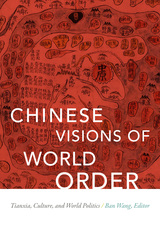 Chinese Visions of World Order: Tianxia, Culture, and World Politics
Ban Wang, editor
Duke University Press, 2017 The Confucian doctrine of tianxia (all under heaven) outlines a unitary worldview that cherishes global justice and transcends social, geographic, and political divides. For contemporary scholars, it has held myriad meanings, from the articulation of a cultural imaginary and political strategy to a moralistic commitment and a cosmological vision. The contributors to Chinese Visions of World Order examine the evolution of tianxia's meaning and practice in the Han dynasty and its mutations in modern times. They attend to its varied interpretations, its relation to realpolitik, and its revival in twenty-first-century China. They also investigate tianxia's birth in antiquity and its role in empire building, invoke its cultural universalism as a new global imagination for the contemporary world, analyze its resonance and affinity with cosmopolitanism in East-West cultural relations, discover its persistence in China's socialist internationalism and third world agenda, and critique its deployment as an official state ideology. In so doing, they demonstrate how China draws on its past to further its own alternative vision of the current international system.
Contributors. Daniel A. Bell, Chishen Chang, Kuan-Hsing Chen, Prasenjit Duara, Hsieh Mei-yu, Haiyan Lee, Mark Edward Lewis, Lin Chun, Viren Murthy, Lisa Rofel, Ban Wang, Wang Hui, Yiqun Zhou
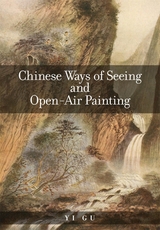 Chinese Ways of Seeing and Open-Air Painting
Yi Gu
Harvard University Press, 2020 How did modern Chinese painters see landscape? Did they depict nature in the same way as premodern Chinese painters? What does the artistic perception of modern Chinese painters reveal about the relationship between artists and the nation-state? Could an understanding of modern Chinese landscape painting tell us something previously unknown about art, political change, and the epistemological and sensory regime of twentieth-century China?
Yi Gu tackles these questions by focusing on the rise of open-air painting in modern China. Chinese artists almost never painted outdoors until the late 1910s, when the New Culture Movement prompted them to embrace direct observation, linear perspective, and a conception of vision based on Cartesian optics. The new landscape practice brought with it unprecedented emphasis on perception and redefined artistic expertise. Central to the pursuit of open-air painting from the late 1910s right through to the early 1960s was a reinvigorated and ever-growing urgency to see suitably as a Chinese and to see the Chinese homeland correctly. Examining this long-overlooked ocular turn, Gu not only provides an innovative perspective from which to reflect on complicated interactions of the global and local in China, but also calls for rethinking the nature of visual modernity there.
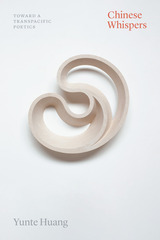 Chinese Whispers: Toward a Transpacific Poetics
Yunte Huang
University of Chicago Press, 2022 Chinese Whispers examines multiple contact zones between the Anglophone and Sinophone worlds, investigating how poetry both enables and complicates the transpacific production of meaning.
In this new book, the noted critic and best-selling author Yunte Huang explores the dynamics of poetry and poetics in the age of globalization, particularly questions of translatability, universality, and risk in the transpacific context. “Chinese whispers” refers to an American children’s game dating to the years of the Cold War, a period in which everything Chinese, or even Chinese sounding, was suspect. Taking up various manifestations of the phrase in the twentieth and twenty-first centuries, Huang investigates how poetry, always to a significant degree untranslatable, complicates the transpacific production of meanings and values.
The book opens with the efforts of I. A. Richards, arguably the founder of Anglo-American academic literary criticism, to promote Basic English in China in the early twentieth century. It culminates by resituating Ernest Fenollosa’s famous essay “The Chinese Written Character as a Medium for Poetry,” exploring the ways in which Chinese has historically enriched but also entrapped the Western conception of language.
Chinese Women and the Cyberspace
Edited by Khun Eng Kuah-Pearce
Amsterdam University Press, 2008
This volume examines how Chinese women negotiate the Internet as a research tool and a strategy for the acquisition of information, as well as for social networking purposes. Offering insight into the complicated creation of a female Chinese cybercommunity, Chinese Women and the Cyberspace discusses the impact of increasingly available Internet technology on the life and lifestyle of Chinese women—examining larger issues of how women become both masters of their electronic domain and the objects of exploitation in a faceless online world.
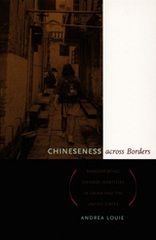 Chineseness across Borders: Renegotiating Chinese Identities in China and the United States
Andrea Louie
Duke University Press, 2004 What happens when Chinese American youths travel to mainland China in search of their ancestral roots, only to realize that in many ways they still feel out of place, or when mainland Chinese realize that the lives of the Chinese abroad may not be as good as they had imagined? By considering programs designed to facilitate interactions between overseas Chinese and their ancestral homelands, Andrea Louie highlights how these programs not only create opportunities for new connections but also reveal the disjunctures that now separate Chinese Americans from China and mainland Chinese from the Chinese abroad. Louie focuses on “In Search of Roots,” a program that takes young Chinese American adults of Cantonese descent to visit their ancestral villages in China’s Guangdong province. Through ethnographic interviews and observation, Louie examines the experiences of Chinese Americans both during village visits in China and following their participation in the program, which she herself took part in as an intern and researcher. She presents a vivid portrait of two populations who, though connected through family ties generations back, are meeting for the first time in the context of a rapidly changing contemporary China. Louie situates the participants’ and hosts’ shifting understandings of China and Chineseness within the context of transnational flows of people, media, goods, and money; China’s political and economic policies; and the racial and cultural politics of the United States.
Ch’ing Administration: Three Studies
John King Fairbank and Ssu-yü Têng
Harvard University Press When these studies of the Ch’ing bureaucracy and its procedures were first published, they were a pioneer investigation. They still are. The day-to-day administration during this period has received little subsequent attention. The papers are: On the Transmission of Ch’ing Documents, On the Types and Uses of Ch’ing Documents, and On the Ch’ing Tributary System.
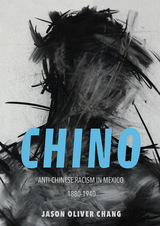 Chino: Anti-Chinese Racism in Mexico, 1880-1940
Jason Oliver Chang
University of Illinois Press, 2017 From the late nineteenth century to the 1930s, antichinismo --the politics of racism against Chinese Mexicans--found potent expression in Mexico. Jason Oliver Chang delves into the untold story of how antichinismo helped the revolutionary Mexican state, and the elite in control, of it build their nation. As Chang shows, anti-Chinese politics shared intimate bonds with a romantic ideology that surrounded the transformation of the mass indigenous peasantry into dignified mestizos. Racializing a Chinese Other became instrumental in organizing the political power and resources for winning Mexico's revolutionary war, building state power, and seizing national hegemony in order to dominate the majority Indian population. By centering the Chinese in the drama of Mexican history, Chang opens up a fascinating untold story about the ways antichinismo was embedded within Mexico's revolutionary national state and its ideologies. Groundbreaking and boldly argued, Chino is a first-of-its-kind look at the essential role the Chinese played in Mexican culture and politics.
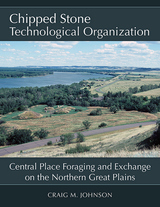 Chipped Stone Technological Organization: Central Place Foraging and Exchange on the Northern Great Plains
Craig M. Johnson
University of Utah Press, 2019 Over a 40-year period, Craig Johnson collected data on chipped stone tools from nearly 200 occupations along the Missouri River in the Dakotas. This book integrates those data with central place foraging theory and exchange models to arrive at broad conclusions supporting archaeological theory. The emphasis is on the last 1,000 years, when the Mandan, Hidatsa, and Arikara farmer-hunters dominated the area, but also looks back some 10,000 years to more nomadic peoples. The long timespan and large number of villages and campsites help define changes through time and over large distances of local and nonlocal tool stone and its manufacture into arrow points, knives, and other tools.
Central place foraging theory, through the field processing model, posits that the farther a source material is from the central living area, the more it will be processed before it is transported back, to avoid hauling heavy, nonusable parts on long trips. Johnson’s data support this theory and demonstrate that this model applies not only to nomadic hunter-gatherers but also to semisedentary farmer-hunters. His results also indicate that toolstone usage creates distinctive spatial patterns along the Missouri River, largely related to village distance from the sources. This is best illustrated with Knife River flint, which gradually declines in popularity downriver from its source in west-central North Dakota but increases in central South Dakota because of exchange.
Chipped Stone Tools in Formative Oaxaca, Mexico: Their Procurement, Production and Use
William J. Parry
University of Michigan Press, 1987 Chipped stone tools from archaeological sites can be a source of social and economic information about the inhabitants. In this volume, author William J. Parry presents his analysis of chipped stone tools found at Early and Middle Formative sites in the Valley of Oaxaca, Mexico. Volume 8 of the subseries Prehistory and Human Ecology of the Valley of Oaxaca.
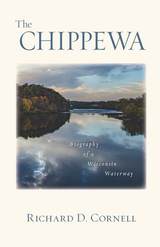 The Chippewa: Biography of a Wisconsin Waterway
Richard D. Cornell
Wisconsin Historical Society Press, 2017 Inspired by August Derleth’s seminal book The Wisconsin, Richard D. Cornell traveled the Chippewa River from its two sources south of Ashland to where it joins the Mississippi. Over several decades he returned time and again in his red canoe to immerse himself in the stories of the Chippewa River and document its valley, from the Ojibwe and early fur traders and lumbermen to the varied and hopeful communities of today. Cornell shares tales of such historical figures as legendary Ojibwe leader Chief Buffalo, world famous wrestler Charlie Fisher, and supercomputer innovator Seymour Cray, along with the lesser-known stories of local luminaries such as Dr. John "Little Bird" Anderson. Cornell gathered firsthand stories from diners and dives, local museums and landmarks, quaint small-town newspaper offices, and the homes of old-timers and local historians. Through his conversations with ordinary people, he gets at the heart of the Chippewa and shares a history of the river that is both one of a kind and deeply personal.
Chippewa Lake: A Community in Search of an Identity
Cindy L. Hull
Michigan State University Press, 2012 Chippewa Lake is an idyllic waterfront community in north-central Michigan, popular with retirees and weekenders. The lake is surrounded by a rural farming community, but the area is facing a difficult transition as local demographics shift, and as it transforms from an agriculture-based economy to one that relies on wage labor. As farms have disappeared, local residents have employed a variety of strategies to adapt to a new economic structure. The community, meanwhile, has been indelibly affected by the advent of newcomers and retirees challenging the rural cultural values. An anthropologist with a background in sociology, Cindy L. Hull deftly weaves together oral accounts, historic documents, and participant surveys compiled from her nearly thirty years of living in the area to create a textured portrait of a community in flux.
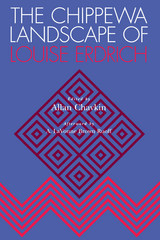 The Chippewa Landscape of Louise Erdrich
Allan Chavkin
University of Alabama Press, 1999 This volume of new essays provides the first book-length critical assessment of the fiction of America's best-known contemporary writer of Native American heritage. Louise Erdrich is arguably the most prolific and prominent contemporary writer of American Indian descent in North America today. Her novels and short stories have won great critical acclaim and are widely taught in American and world literature courses. This collection of original ssays focuses on Erdrich's writings rooted in the Chippewa experience. Premier scholars of Native American literature investigate narrative structure, signs of ethnicity, the notions of luck and chance in Erdrich's narrative cosmology, her use of hunting metaphors, her efforts to counter stereotypes of American Indian women, her use of comedy in exploring American Indians' tragic past, her intentions underlying the process of revision in Love Medicine, and other subjects.
Including a variety of theoretical approaches, this book provides a comprehensive examination of Erdrich's work, making it more accessible to new readers and richer to those already familiar with her work.
Chiquinho: A Novel of Cabo Verde
Baltazar Lopes
Tagus Press, 2019
Originally published in Portuguese in 1947, Baltazar Lopes's Chiquinho offers a rich and compelling exploration of Cabo Verde's unique identity. Tracing the arc of its young protagonist's life as he approaches adulthood, the novel follows Chiquinho as he leaves his village, journeys to São Vicente Island to further his education, returns home as drought and famine strike the archipelago, and makes the difficult decision to join his father in New Bedford, Massachusetts. Reflecting the challenges faced by the Creole intellectuals of the socalled Claridade generation, this longoverdue English translation of Chiquinho is sure to appeal to academic audiences as well as the general reader.
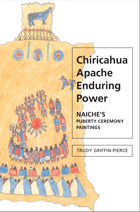 Chiricahua Apache Enduring Power: Naiche's Puberty Ceremony Paintings
Trudy Griffin-Pierce, foreword by J. Jefferson Reid and Stephanie M. Whittlesey
University of Alabama Press, 2006 A gripping story of the cultural resilience of the descendants of Geronimo and Cochise This book reveals the conflicting meanings of power held by the federal government and the Chiricahua Apaches throughout their history of interaction. When Geronimo and Naiche, son of Cochise, surrendered in 1886, their wartime exploits came to an end, but their real battle for survival was only beginning. Throughout their captivity in Florida, Alabama, and Oklahoma, Naiche kept alive Chiricahua spiritual power by embodying it in his beautiful hide paintings of the Girl’s Puberty Ceremony—a ritual at the very heart of tribal cultural life and spiritual strength. This narrative is a tribute to the Chiricahua people, who survive today, despite military efforts to annihilate them, government efforts to subjugate them, and social efforts to destroy their language and culture. Although federal policy makers brought to bear all the power at their command, they failed to eradicate Chiricahua spirit and identity nor to convince them that their lower status was just part of the natural social order. Naiche, along with many other Chiricahuas, believed in another kind of power. Although not known to have Power of his own in the Apache sense, Naiche’s paintings show that he believed in a vital source of spiritual strength. In a very real sense, his paintings were visual prayers for the continuation of the Chiricahua people. Accessible to individuals for many purposes, Power helped the Chiricahuas survive throughout their history.
In this book, Griffin-Pierce explores Naiche’s artwork through the lens of current anthropological theory on power, hegemony, resistance, and subordination. As she retraces the Chiricahua odyssey during 27 years of incarceration and exile by visiting their internment sites, she reveals how the Power was with them throughout their dark period. As it was when the Chiricahua warriors and their families struggled to stay alive, Power remains the centering focus for contemporary Chiricahua Apaches. Although never allowed to return to their beloved homeland, not only are the Chiricahua Apaches surviving today, they are keeping their traditions alive and their culture strong and vital.
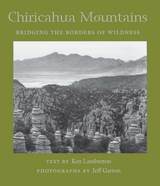 Chiricahua Mountains: Bridging the Borders of Wildness
Text by Ken Lamberton; Photographs by Jeff Garton
University of Arizona Press, 2003 For many, these mountains represent the Apache stronghold of Geronimo. For others, they are a birdwatcher's paradise. But the Chiricahua Mountains of southeastern Arizona are more than this. They are a classic "sky island" of the desert, a rich storehouse of biologic diversity. On a journey undertaken in search of a pair of rare short-tailed hawks, Ken Lamberton takes readers on an excursion through these mountains, from their riparian canyons to their highest peaks. The Chiricahuas comprise the largest single range in southern Arizona, crisscrossed by more than 300 miles of trails. Lamberton is your guide along these trails, and his knowledge of the mountains and their natural history makes him a perfect hiking companion while Jeff Garton's stunning photographs enrich your visit.
Lamberton shares insights about the geology, habitats, and diversity of wildlife in a place of such isolation that species must either adapt or become extinct. The Chiricahuas are one link in a chain of mountains connecting the Rockies to the Sierra Madre Occidental in Mexico, and some Madrean species reach the northernmost extension of their ranges here: birds like sulphur-bellied flycatchers, mammals like jaguarundis, and trees like the Apache pine. But this is not an untraveled wilderness. We learn why the Chiricahuas are so popular with birders, who flock to these mountains from around the world in the hopes of spotting some of the nearly four hundred avian species found here. We also learn something of the Chiricahua's rich human culture, from Apache warriors to European settlers.
Gracing the text are more than a dozen black-and-white photographs by Jeff Garton that offer views of the Chiricahuas different from those usually found in tourist brochures: landscapes and riparian settings, rock formations and plant studies that give readers a lasting impression of the beauty and tranquility of this wilderness. Together words and images convey an intimate view of one of the Southwest's most exotic locations—stronghold, paradise, and everlasting island in the vast and rolling desert.
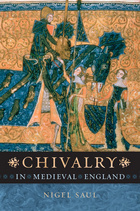 Chivalry in Medieval England
Nigel Saul
Harvard University Press, 2011 Popular views of medieval chivalry—knights in shining armor, fair ladies, banners fluttering from battlements—were inherited from the nineteenth-century Romantics. This is the first book to explore chivalry’s place within a wider history of medieval England, from the Norman Conquest to the aftermath of Henry VII’s triumph at Bosworth in the Wars of the Roses.
Saul invites us to view the world of castles and cathedrals, tournaments and round tables, with fresh eyes. Chivalry in Medieval England charts the introduction of chivalry by the Normans, the rise of the knightly class as a social elite, the fusion of chivalry with kingship in the fourteenth century, and the influence of chivalry on literature, religion, and architecture. Richard the Lionheart and the Crusades, the Black Death and the Battle of Crecy, the Magna Carta and the cult of King Arthur—all emerge from the mists of time and legend in this vivid, authoritative account.
Chivalry, Reading, and Women's Culture in Early Modern Spain: From Amadís de Gaula to Don Quixote
Stacey Triplette
Amsterdam University Press, 2018 The Iberian chivalric romance has long been thought of as an archaic, masculine genre and its popularity as an aberration in European literary history. Chivalry, Reading, and Women’s Culture in Early Modern Spain contests this view, arguing that the surprisingly egalitarian gender politics of Spain’s most famous romance of chivalry has guaranteed it a long afterlife. Amadís de Gaula had a notorious appeal for female audiences, and the early modern authors who borrowed from it varied in their reactions to its large cast of literate female characters. Don Quixote and other works that situate women as readers carry the influence of Amadís forward into the modern novel. When early modern authors read chivalric romance, they also read gender, harnessing the female characters of the source text to a variety of political and aesthetic purposes.
Chocolate and Blackness: A Cultural History
Silke Hackenesch
Campus Verlag, 2017 This book draws out a number of unexpected connections between chocolate and blackness as both idea and reality. Silke Hackenesch builds her argument around four main focal points. First is the modes of production of chocolate—the economic realities of the business and the material connection between blackness and chocolate. Second is the semantics of chocolate, while its iconography is analyzed third. Finally, she addresses the use of chocolate as a racial signifier, showing that it is deployed differently by African Americans and Afro-Germans, for example.
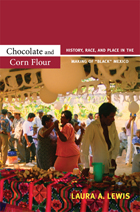 Chocolate and Corn Flour: History, Race, and Place in the Making of "Black" Mexico
Laura A. Lewis
Duke University Press, 2012 Located on Mexico's Pacific coast in a historically black part of the Costa Chica region, the town of San Nicolás has been identified as a center of Afromexican culture by Mexican cultural authorities, journalists, activists, and foreign anthropologists. The majority of the town's residents, however, call themselves morenos (black Indians). In Chocolate and Corn Flour, Laura A. Lewis explores the history and contemporary culture of San Nicolás, focusing on the ways that local inhabitants experience and understand race, blackness, and indigeneity, as well as on the cultural values that outsiders place on the community and its residents. Drawing on more than a decade of fieldwork, Lewis offers a richly detailed and subtle ethnography of the lives and stories of the people of San Nicolás, including community residents who have migrated to the United States. San Nicoladenses, she finds, have complex attitudes toward blackness—as a way of identifying themselves and as a racial and cultural category. They neither consider themselves part of an African diaspora nor deny their heritage. Rather, they acknowledge their hybridity and choose to identify most deeply with their community.
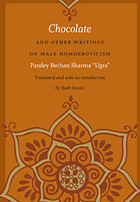 Chocolate and Other Writings on Male Homoeroticism
Pandey Bechan Sharma
Duke University Press, 2009 This volume makes available for the first time in English the work of a significant Indian nationalist author, Pandey Bechan Sharma, better known in India as “Ugra,” meaning “extreme.” His book Chocolate, a 1927 collection of eight stories, was the first work of Hindi fiction to focus on male same-sex relations, and its publication sparked India’s first public debates about homosexuality. Many prominent figures, including Gandhi, weighed in on the debates, which lasted into the 1950s. This edition, translated and with an introduction by Ruth Vanita, includes the full text of Chocolate along with an excerpt from Ugra’s novel Letters of Some Beautiful Ones (also published in 1927). In her introduction, Vanita situates Ugra and his writings in relation to Indian nationalist struggles and Hindi literary movements and feuds, and she analyzes the controversies that surrounded Chocolate. Those outraged by its titillating portrayal of homosexuality labeled the collection obscene. On the other side, although no one explicitly defended homosexuality in public, some justified Ugra’s work by arguing that it was the artist’s job to educate through provocation. The stories depict male homoeroticism in quotidian situations: a man brings a lover to his disapproving friend’s house; a good-looking young man becomes the object of desire at his school. The love never ends well, but the depictions are not always unsympathetic. Although Ugra claimed that the stories were aimed at suppressing homosexuality by exposing it, Vanita highlights the ambivalence of his characterizations. Cosmopolitan, educated, and hedonistic, the Hindu and Muslim men he portrayed quote Hindi and Urdu poetry to express their love, and they justify same-sex desire by drawing on literature, philosophy, and world history. Vanita’s introduction includes anecdotal evidence that Chocolate was enthusiastically received by India’s homosexual communities.
 Chocolate Islands: Cocoa, Slavery, and Colonial Africa
Catherine Higgs
Ohio University Press In Chocolate Islands: Cocoa, Slavery, and Colonial Africa, Catherine Higgs traces the early-twentieth-century journey of the Englishman Joseph Burtt to the Portuguese colony of São Tomé and Príncipe—the chocolate islands—through Angola and Mozambique, and finally to British Southern Africa. Burtt had been hired by the chocolate firm Cadbury Brothers Limited to determine if the cocoa it was buying from the islands had been harvested by slave laborers forcibly recruited from Angola, an allegation that became one of the grand scandals of the early colonial era. Burtt spent six months on São Tomé and Príncipe and a year in Angola. His five-month march across Angola in 1906 took him from innocence and credulity to outrage and activism and ultimately helped change labor recruiting practices in colonial Africa.
This beautifully written and engaging travel narrative draws on collections in Portugal, the United Kingdom, and Africa to explore British and Portuguese attitudes toward work, slavery, race, and imperialism. In a story still familiar a century after Burtt’s sojourn, Chocolate Islands reveals the idealism, naivety, and racism that shaped attitudes toward Africa, even among those who sought to improve the conditions of its workers.
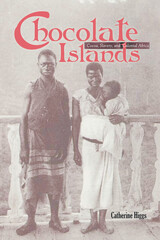 Chocolate Islands: Cocoa, Slavery, and Colonial Africa
Catherine Higgs
Ohio University Press, 2012 In Chocolate Islands: Cocoa, Slavery, and Colonial Africa, Catherine Higgs traces the early-twentieth-century journey of the Englishman Joseph Burtt to the Portuguese colony of São Tomé and Príncipe—the chocolate islands—through Angola and Mozambique, and finally to British Southern Africa. Burtt had been hired by the chocolate firm Cadbury Brothers Limited to determine if the cocoa it was buying from the islands had been harvested by slave laborers forcibly recruited from Angola, an allegation that became one of the grand scandals of the early colonial era. Burtt spent six months on São Tomé and Príncipe and a year in Angola. His five-month march across Angola in 1906 took him from innocence and credulity to outrage and activism and ultimately helped change labor recruiting practices in colonial Africa. This beautifully written and engaging travel narrative draws on collections in Portugal, the United Kingdom, and Africa to explore British and Portuguese attitudes toward work, slavery, race, and imperialism. In a story still familiar a century after Burtt’s sojourn, Chocolate Islands reveals the idealism, naivety, and racism that shaped attitudes toward Africa, even among those who sought to improve the conditions of its workers.
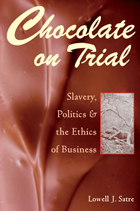 Chocolate on Trial: Slavery, Politics, and the Ethics of Business
Lowell J. Satre
Ohio University Press, 2005 At the turn of the twentieth century, Cadbury Bros. Ltd. was a successful, Quaker-owned chocolate manufacturer in Birmingham, England, celebrated for its model village, modern factory, and concern for employees. In 1901 the firm learned that its cocoa beans, purchased from Portuguese plantations on the island of São Tomé off West Africa, were produced by slave labor.
Chocolate on Trial: Cadbury, Slavery and the Economics of Virtue in Imperial Britain gives a lively and highly readable account of the events surrounding the libel trial in which Cadbury Bros. Ltd. sued the London Standard, following the newspaper's accusation that the firm was hypocritical in its use of slave-grown cocoa. As compelling now as at the turn of the previous century, the issues probed by Lowell J. Satre give invaluable historical background to contemporary issues of business ethics, corporate social responsibility, and globalization. The story Satre tells illuminates what a stubbornly persistent institution slavery was and shows how Cadbury, a company with a well-regarded brand name and logo, endured ethical dilemmas and challenges to its record for social responsibility. Chocolate on Trial brings to life the age-old conflict between economic interests and the value of human life.
Satre illuminates the stubborn persistence of the institution of slavery and shows how Cadbury, a company with a well-regarded brand name from the nineteenth century, faced ethical dilemmas and challenges to its record for social responsibility. Chocolate on Trial brings to life the age-old conflict between economic interests and regard for the dignity of human life.
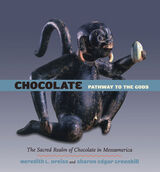 Chocolate: Pathway to the Gods
Meredith L. Dreiss and Sharon Edgar Greenhill
University of Arizona Press, 2008 Chocolate: Pathway to the Gods takes readers on a journey through 3,000 years of the history of chocolate. It is a trip filled with surprises. And it is a beautifully illustrated tour, featuring 132 vibrant color photographs and a captivating sixty-minute DVD documentary. Along the way, readers learn about the mystical allure of chocolate for the peoples of Mesoamerica, who were the first to make it and who still incorporate it into their lives and ceremonies today.
Although it didn’t receive its Western scientific name, Theobroma cacao—“food of the gods”—until the eighteenth century, the cacao tree has been at the center of Mesoamerican mythology for thousands of years. Not only did this “chocolate tree” produce the actual seeds from which chocolate was extracted but it was also symbolically endowed with cosmic powers that enabled a dialogue between humans and their gods. From the pre-Columbian images included in this sumptuous book, we are able to see for ourselves the importance of chocolate to the Maya, Aztecs, Olmecs, Mixtecs, and Zapotecs who grew, produced, traded, and fought over the prized substance.
Through archaeological and other ethnohistoric research, the authors of this fascinating book document the significance of chocolate—to gods, kings, and everyday people—over several millennia. The illustrations allow us to envision the many ancient uses of this magical elixir: in divination ceremonies, in human sacrifices, and even in ball games. And as mythological connections between cacao trees, primordial rainforests, and biodiversity are unveiled, our own quest for ecological balance is reignited. In demonstrating the extraordinary value of chocolate in Mesoamerica, the authors provide new reasons—if any are needed—to celebrate this wondrous concoction.
Chocolate, Strawberry, and Vanilla: A History Of American Ice Cream
Anne Cooper Funderburg
University of Wisconsin Press, 1995 Ice cream has a singular place in American cuisine as both a comfort food and festive treat. Fudge ripple is a consolation for a minor disappointment, and butterscotch swirl is a reward for reaching a personal goal.
Chocolate, Strawberry, and Vanilla traces the evolution of ice cream from a rarity to an everyday indulgence. It covers the genesis of ice cream in America, the invention of the hand-cranked ice cream freezer, the natural ice industry, the beginnings of wholesale ice cream manufacturing, and the origins of the ice cream soda, sundae, cone, sandwich, and bar. It also recounts the histories of many brands, including Dairy Queen, Good Humor, Eskimo Pie, Ben and Jerry's, Baskin-Robbins, and Haagen-Dazs. This history of ice cream reflects and reveals changes in social customs, diet and nutrition, class distinctions, leisure activities, and everyday life.
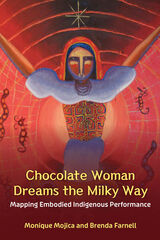 Chocolate Woman Dreams the Milky Way: Mapping Embodied Indigenous Performance
Monique Mojica and Brenda Farnell
University of Michigan Press, 2023 This volume documents the creation of Chocolate Woman Dreams the Milky Way, a play written and performed by Monique Mojica with collaborators from diverse disciplines. Inspired by the pictographic writing and mola textiles of the Guna, an indigenous people of Panama and Colombia, the book explores Mojica’s unique approach to the performance process. Her method activates an Indigenous theatrical process that privileges the body in contrast to Western theater’s privileging of the written text, and rethinks the role of land, body, and movement, as well as dramatic story-structure and performance style.
Co-authored with anthropologist Brenda Farnell, the book challenges the divide between artist and scholar, and addresses the many levels of cultural, disciplinary, and linguistic translations required to achieve this. Placing the complex intellect inherent to Indigenous Knowledges at its center, the book engages Indigenous performance theory, and concepts that link body, land, and story, such as terra nullius/corpus nullius, mapping, pattern literacy, land literacy, and movement literacy. Enhanced by contributions from other artists and scholars, the book challenges Eurocentric ideologies about what counts as “performance” and what is required from an “audience,” as well as long-standing body-mind dualisms.
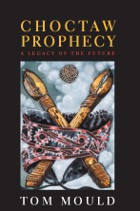 Choctaw Prophecy: A Legacy for the Future
Tom Mould
University of Alabama Press, 2002 Explores the power and artistry of prophecy among the Mississippi Band of Choctaw Indians, who use predictions about the future to interpret the world around them
This book challenges the common assumption that American Indian prophecy was an anomaly of the 18th and 19th centuries that resulted from tribes across the continent reacting to the European invasion. Tom Mould’s study of the contemporary prophetic traditions of the Mississippi Band of Choctaw Indians reveals a much larger system of prophecy that continues today as a vibrant part of the oral tradition.
Mould shows that Choctaw prophecy is more than a prediction of the future; it is a way to unite the past, present, and future in a moral dialogue about how one should live. Choctaw prophecy, he argues, is stable and continuous; it is shared in verbal discourse, inviting negotiation on the individual level; and, because it is a tradition of all the people, it manifests itself through myriad visions with many themes. In homes, casinos, restaurants, laundromats, day care centers, and grocery stores, as well as in ceremonial and political situations, people discuss current events and put them into context with traditional stories that govern the culture. In short, recitation is widely used in everyday life as a way to interpret, validate, challenge, and create the world of the Choctaw speaker.
Choctaw Prophecy stands as a sound model for further study into the prophetic traditions of not only other American Indian tribes but also communities throughout the world. Weaving folklore and oral tradition with ethnography, this book will be useful to academic and public libraries as well as to scholars and students of southern Indians and the modern South.
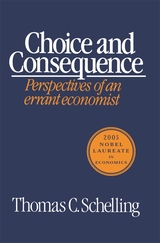 Choice and Consequence
Thomas C. Schelling
Harvard University Press, 1984 Thomas Schelling is a political economist “conspicuous for wandering”—an errant economist. In Choice and Consequence, he ventures into the area where rationality is ambiguous in order to look at the tricks people use to try to quit smoking or lose weight. He explores topics as awesome as nuclear terrorism, as sordid as blackmail, as ineffable as daydreaming, as intimidating as euthanasia. He examines ethical issues wrapped up in economics, unwrapping the economics to disclose ethical issues that are misplaced or misidentified.
With an ingenious, often startling approach, Schelling brings new perspectives to problems ranging from drug abuse, abortion, and the value people put on their lives to organized crime, airplane hijacking, and automobile safety. One chapter is a clear and elegant exposition of game theory as a framework for analyzing social problems. Another plays with the hypothesis that our minds are not only our problem-solving equipment but also the organ in which much of our consumption takes place.
What binds together the different subjects is the author’s belief in the possibility of simultaneously being humane and analytical, of dealing with both the momentous and the familiar. Choice and Consequence was written for the curious, the puzzled, the worried, and all those who appreciate intellectual adventure.
|
|
